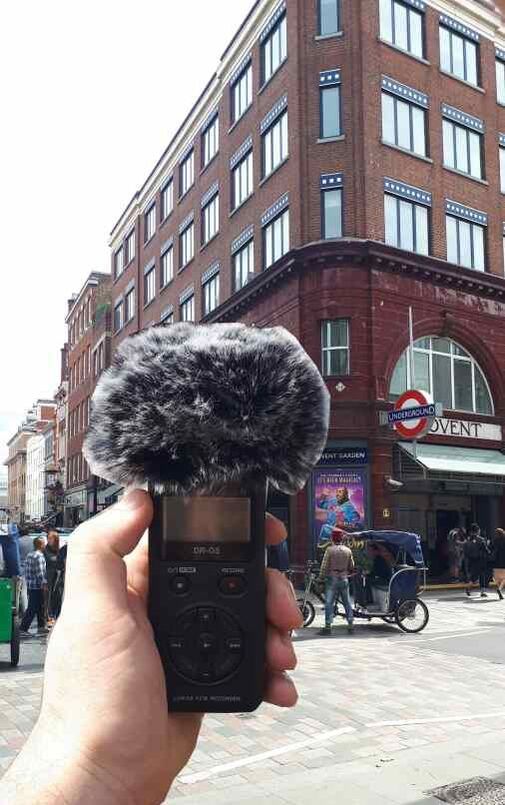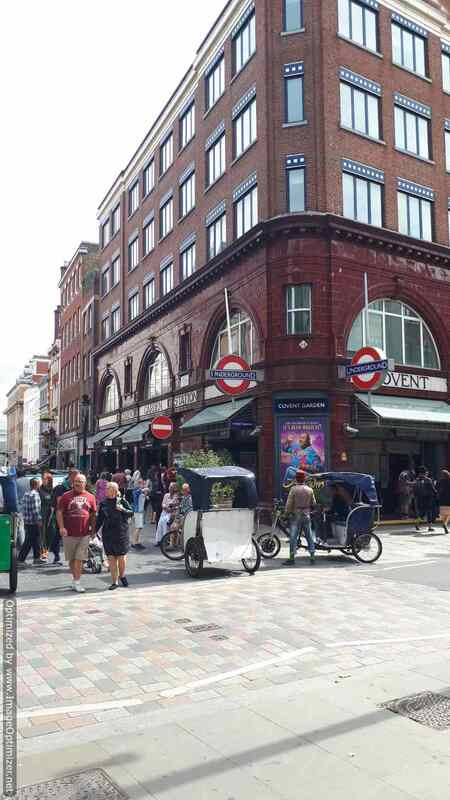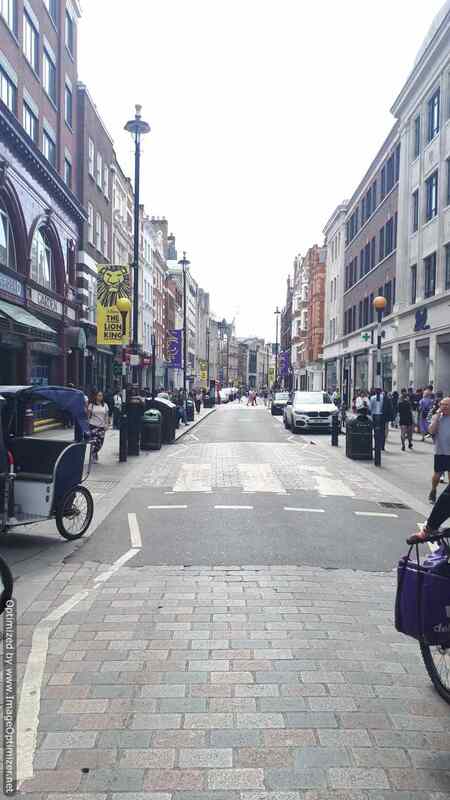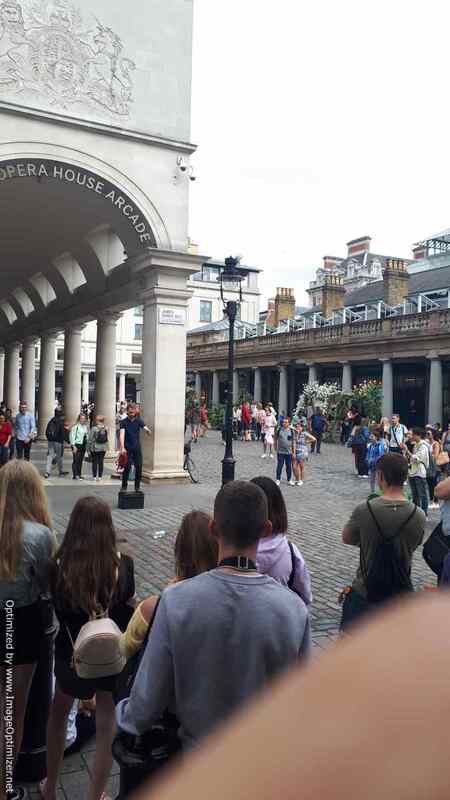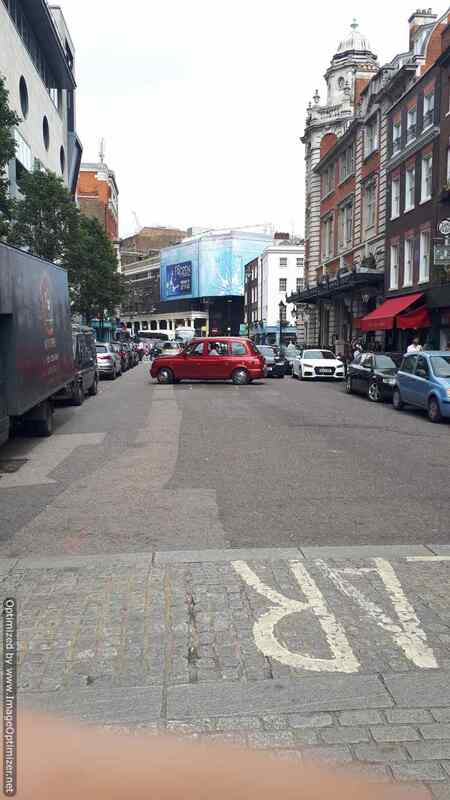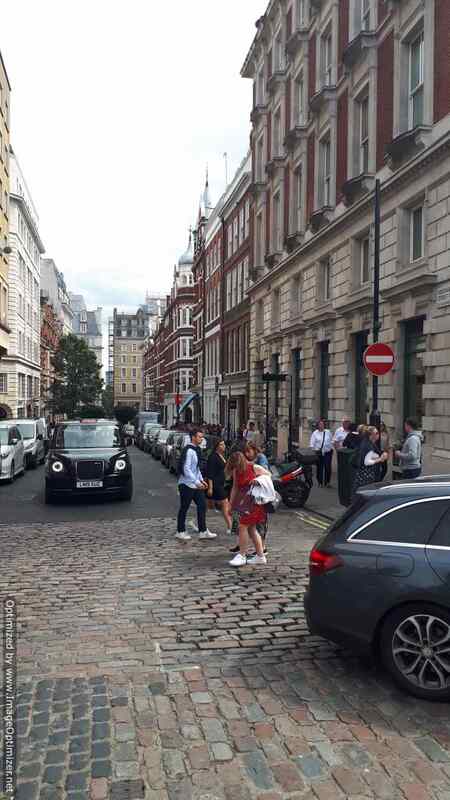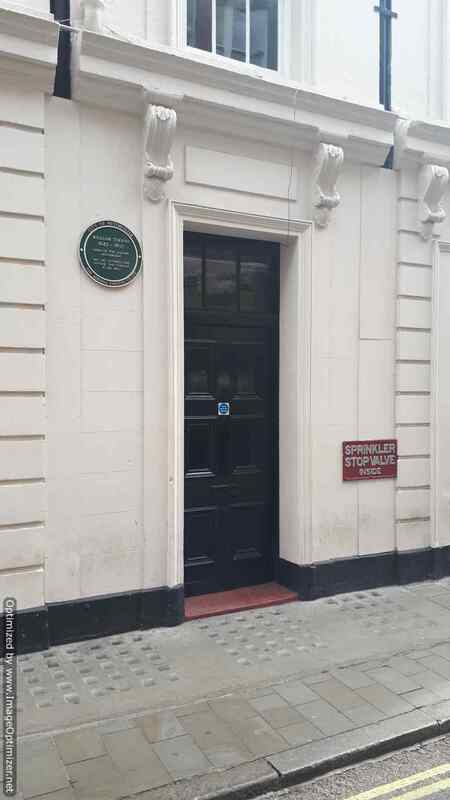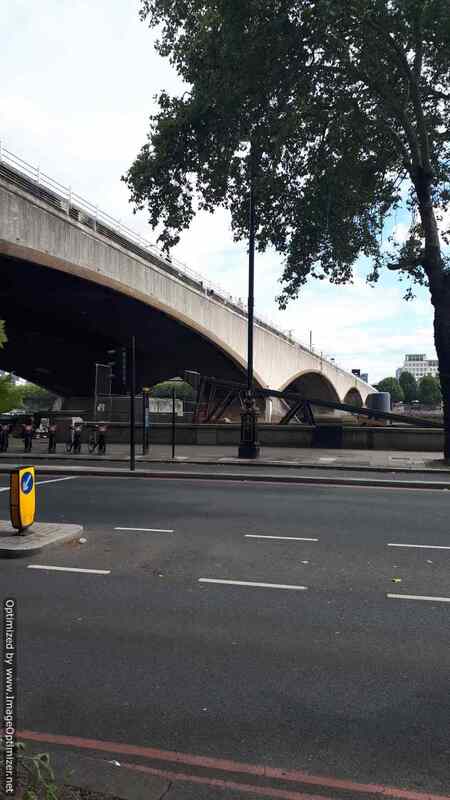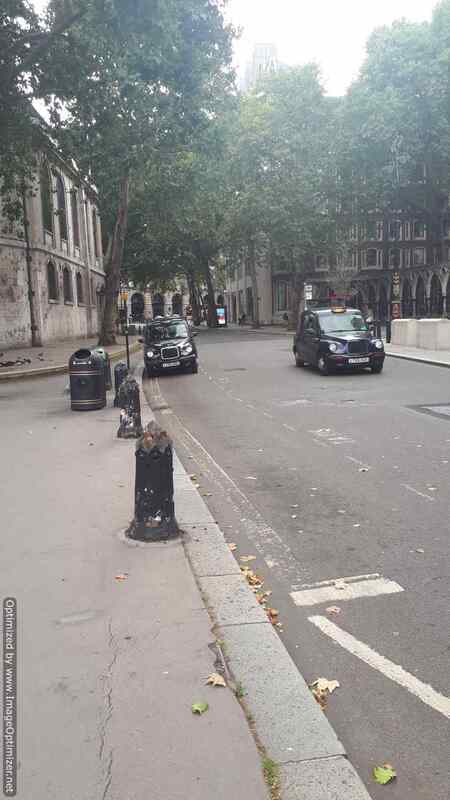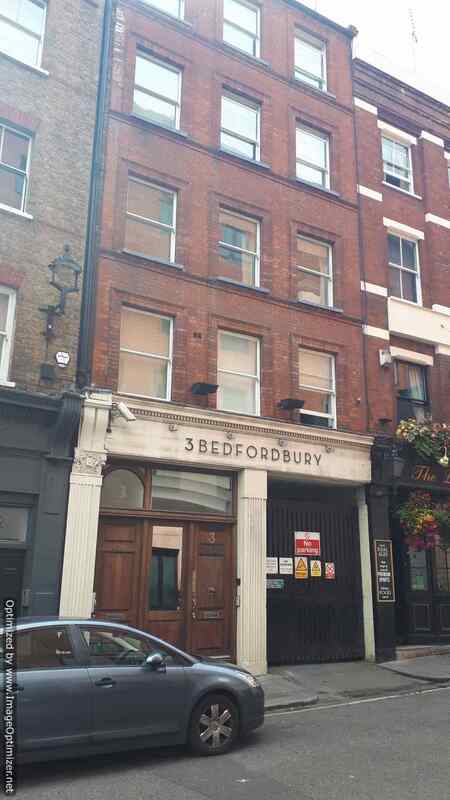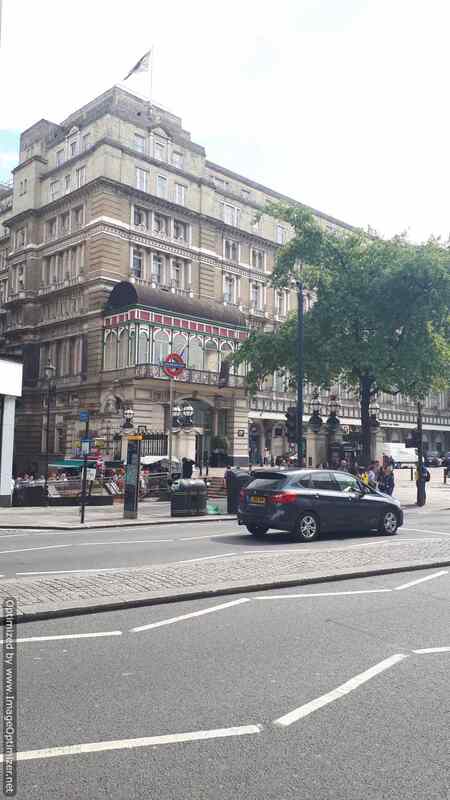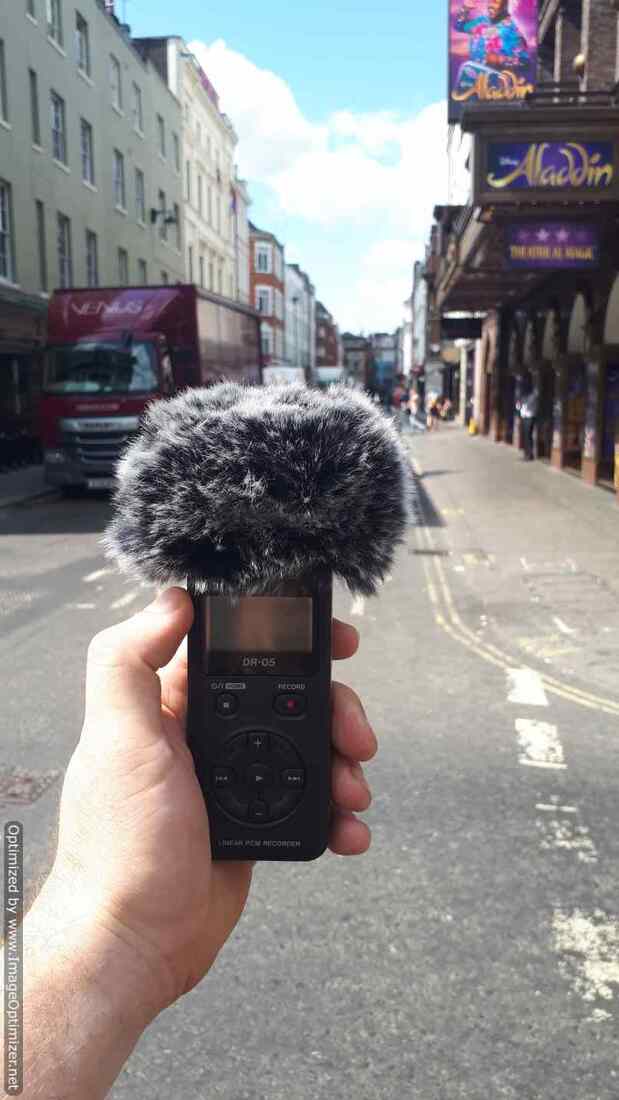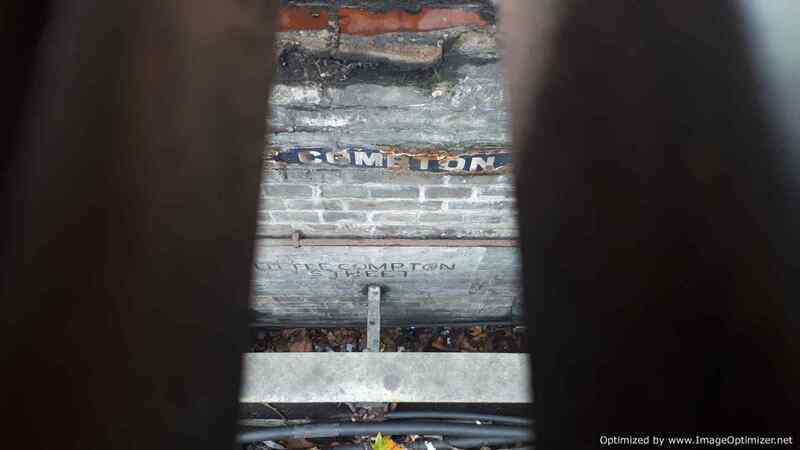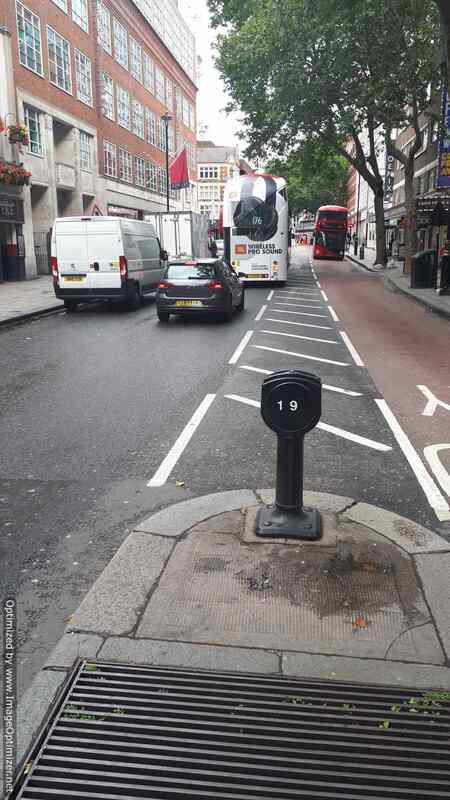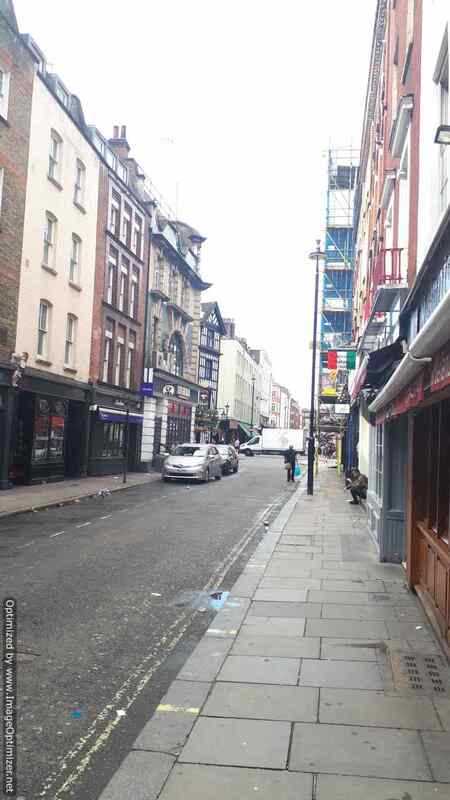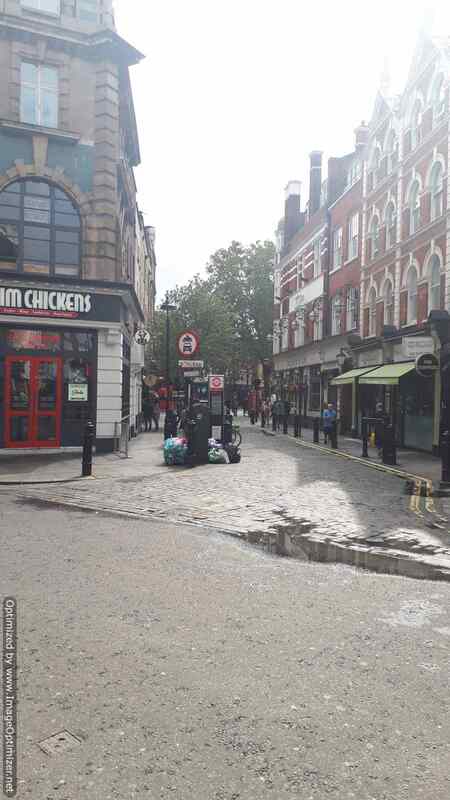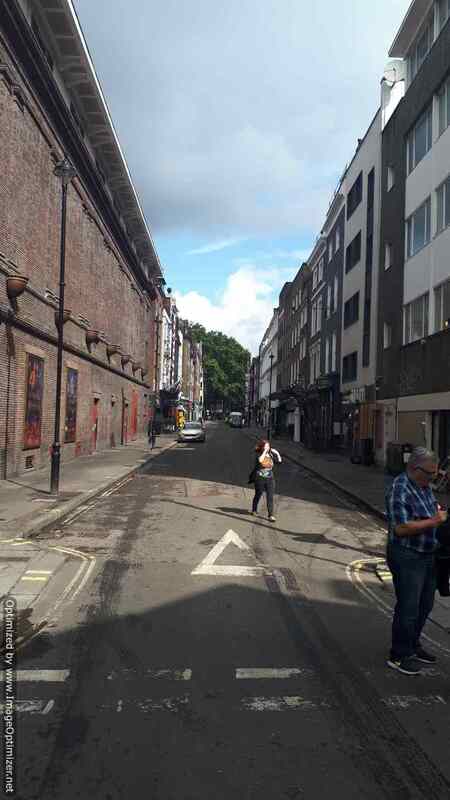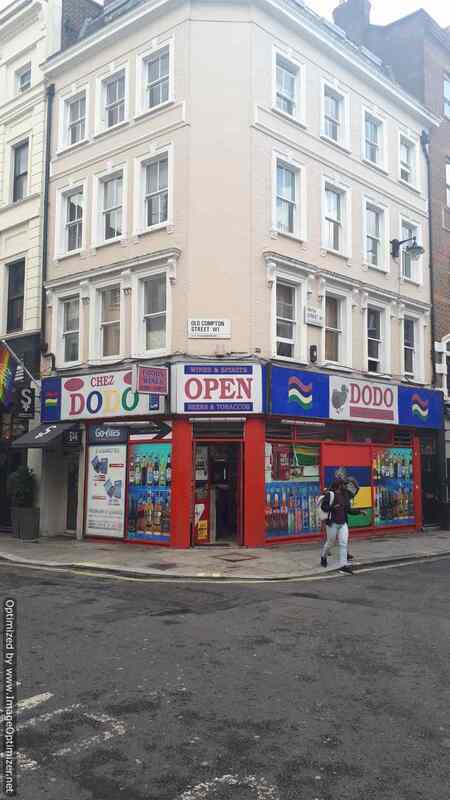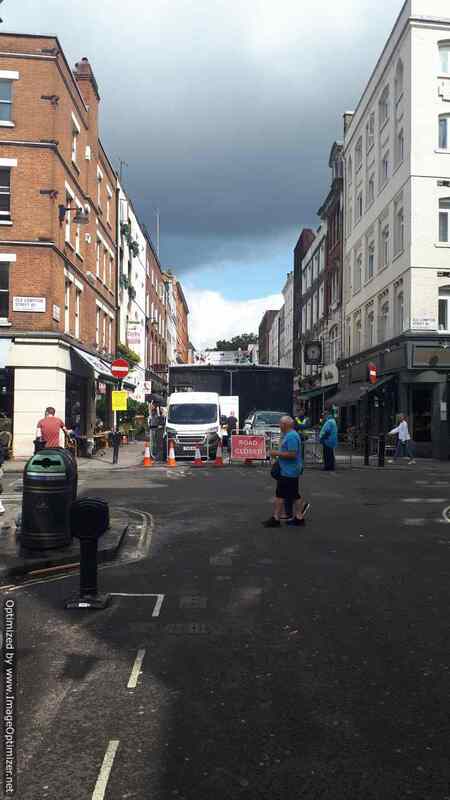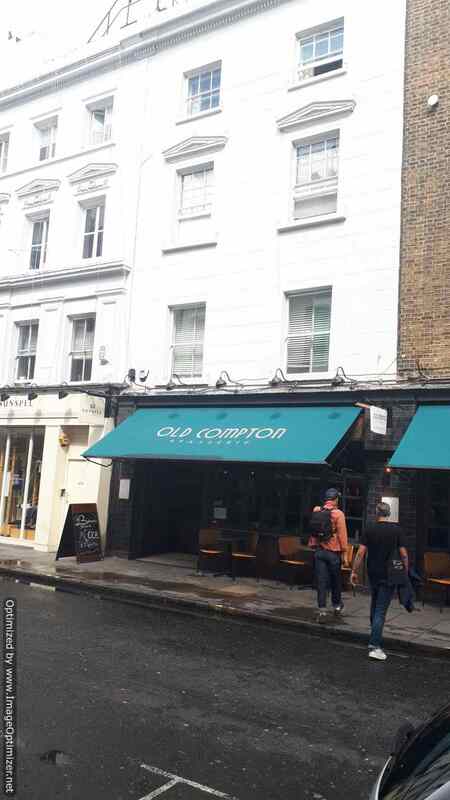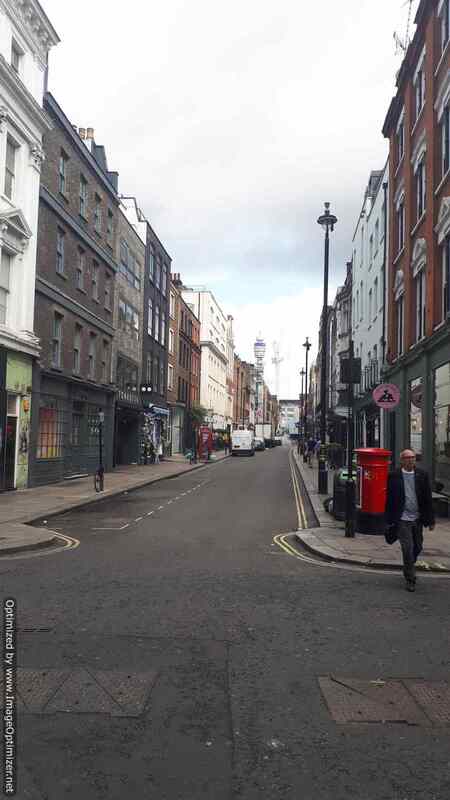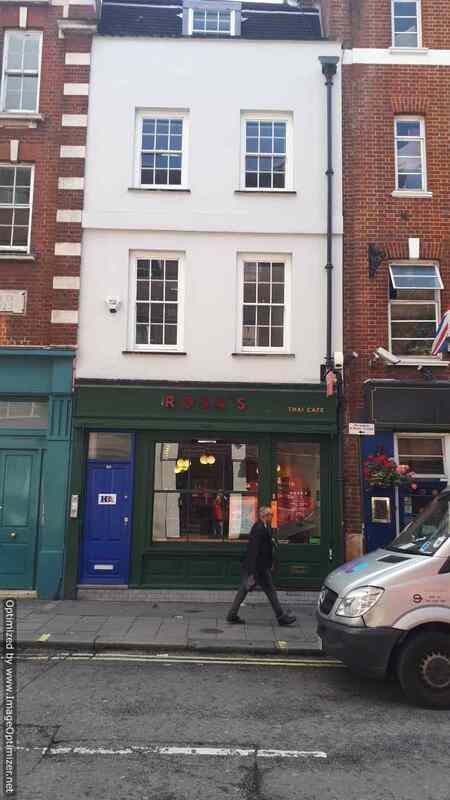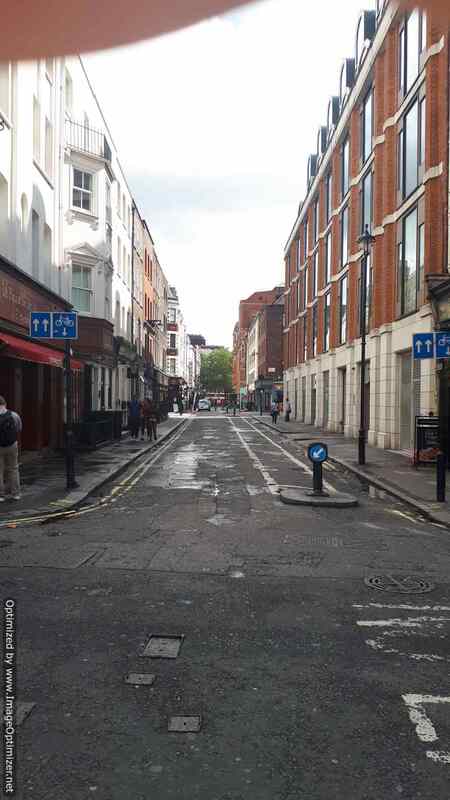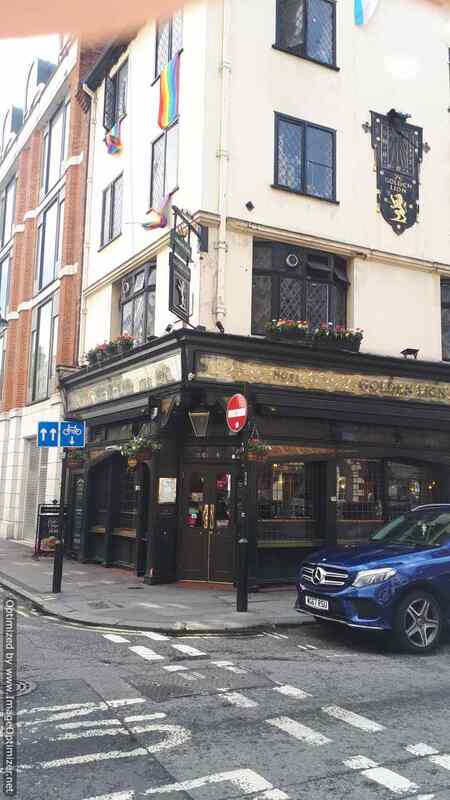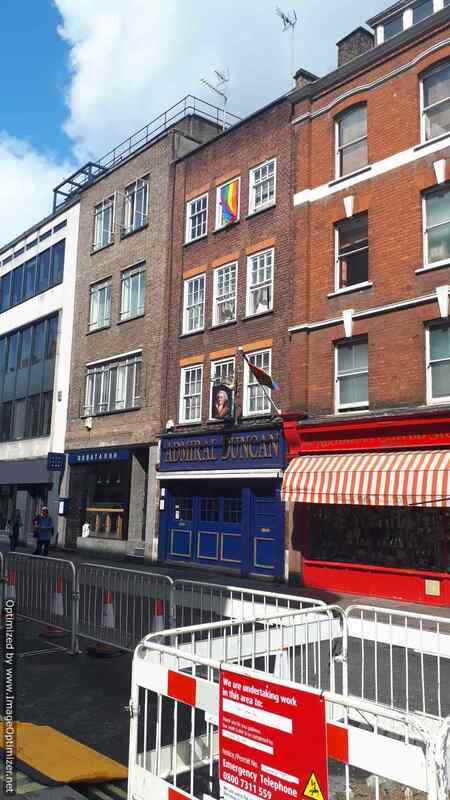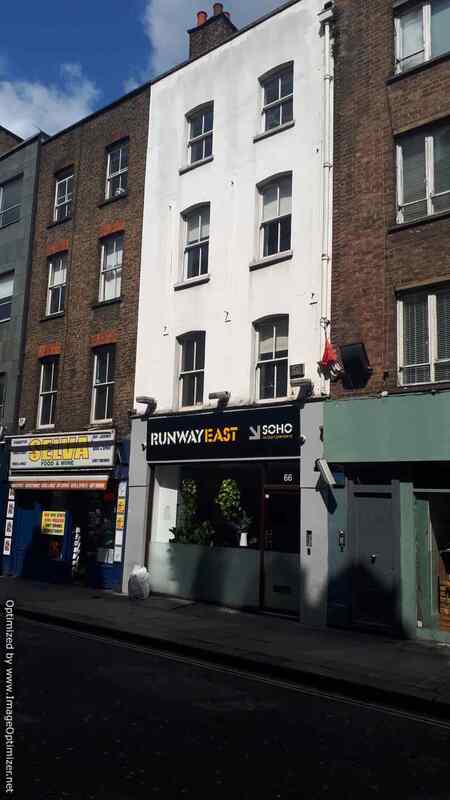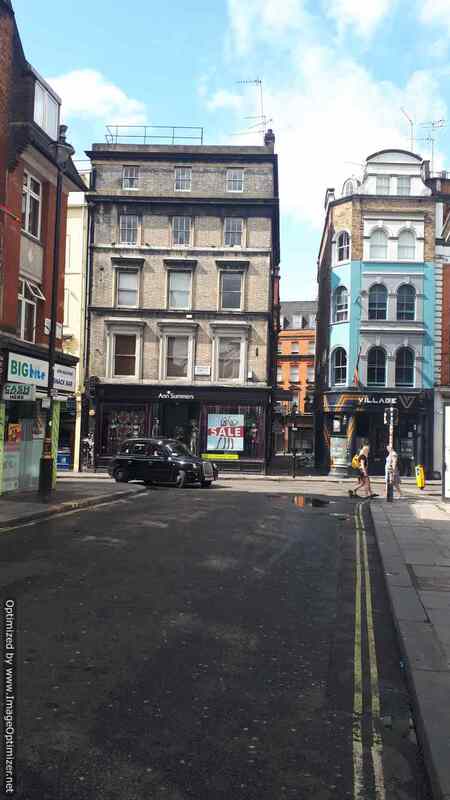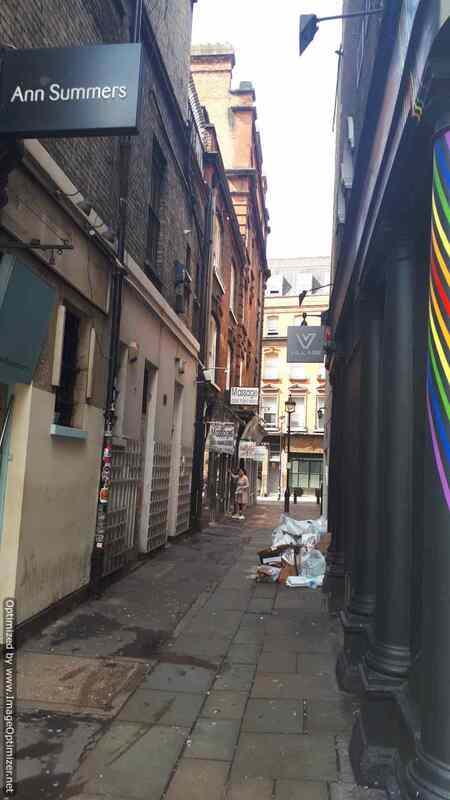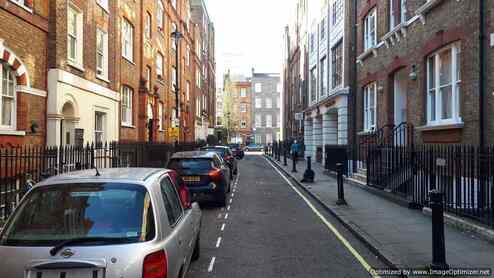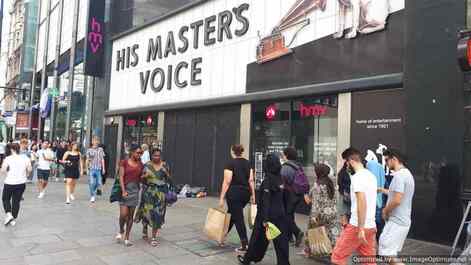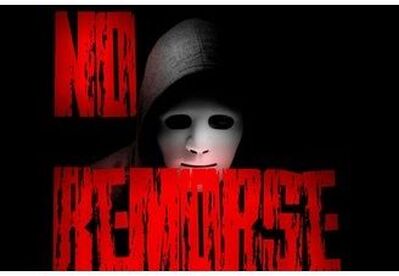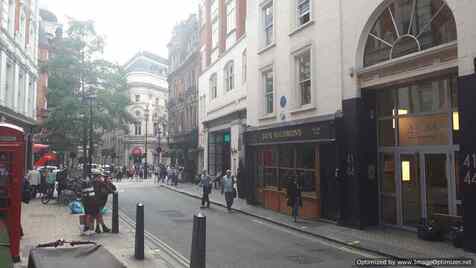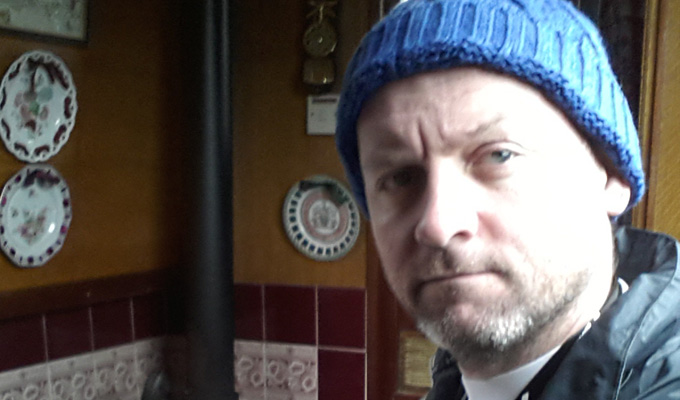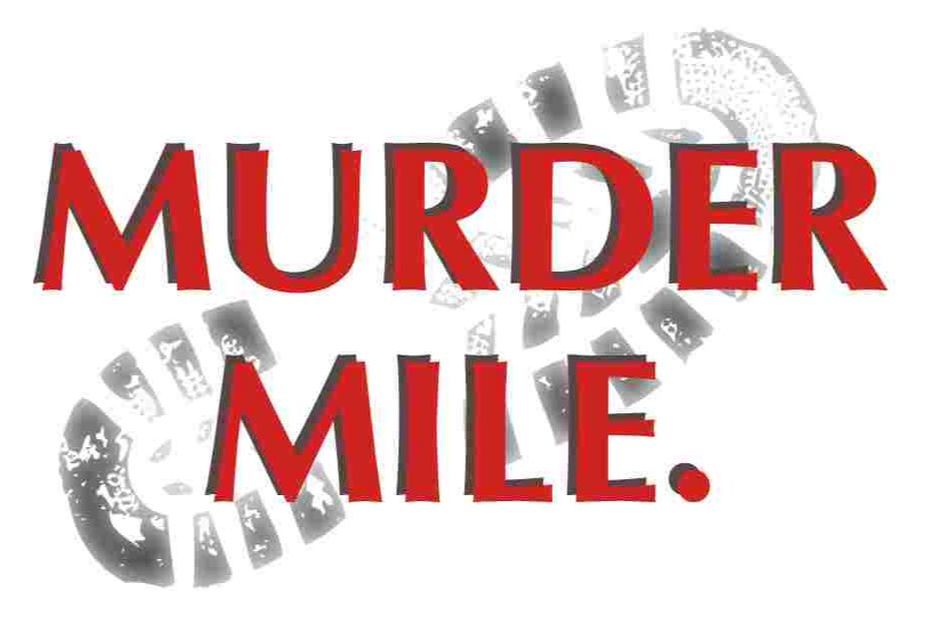|
Nominated BEST TRUE-CRIME PODCAST at British Podcast Awards 2018 and iTunes Top 50. Subscribe via iTunes, Spotify, Acast, Stitcher and all podcast platform.
CLICK HERE to download the Murder Mile podcast via iTunes and to receive the latest episodes, click "subscribe". You can listen to it by clicking PLAY on the embedded media player below.
THE LOCATIONS
For your enjoyment, I've posted photos of the locations discussed in this episode. They're all in chronological order. These photos were taken by myself (copyright Murder Mile).
Credits: Murder Mile was researched, written and recorded by Michael J Buchanan-Dunne, with the music written and performed by Erik Stein & Jon Boux of Cult With No Name.
The music featured in this episode include:
Michael J Buchanan-Dunne is a writer, crime historian, podcaster and tour-guide who runs Murder Mile Walks, a guided tor of Soho’s most notorious murder cases, hailed as “one of the top ten curious, quirky, unusual and different things to do in London”, nominated "one of the best true-crime podcasts at the British podcast Awards 2018", and featuring 12 murderers, including 3 serial killers, across 15 locations, totaling 50 deaths, over just a one mile walk
0 Comments
Nominated BEST TRUE-CRIME PODCAST at British Podcast Awards 2018 and iTunes Top 50. Subscribe via iTunes, Spotify, Acast, Stitcher and all podcast platform. Hello! Fans of True-Crime Podcasts (especially Swedish ones). We've got a real treat for you this week, as this week our True-Crime Podcasters Q&A is hosted by Dan Hörning of the fabulous Seriemördarpodden, a true-crime podcast dedicated to serial-killers.
Michael's thoughts: Obviously I don't speak Swedish, to be honest sometimes I barely speak English, but having spoken to some of my Swedish listeners, they always rave about both of Dan's podcasts, praising them as expertly written, intricately researched, professionally presented and highly addictive. So don't expect a brief overview of a bad-boy, Dan's podcasts go in deep in to the world, the history of the psyche of each serial killer. Take a look, there's more than 100 episodes to choose from, and this includes Fred & Rose West, BTK, Stephen Port and Pee Wee Gaskins, as well as a three part series on Edmund Kemper, a seven part series on Robert Pickton and the Green River Killer, a ten part series on the East Area Rapist and an eleven part series on The Zodiac. I know! Wow! It makes you want to learn Swedish, am I right? I strongly recommend you give it a listen. Mx Q & A with Dan from Seriemördarpodden
A big thank you to Dan for taking part in this True-Crime Podcaster Q & A. Don't forget to check out his podcast. To explore this fine true-crime podcast further, click on the links. . Stay safe my friends Michael.x Michael J Buchanan-Dunne is a writer, crime historian, podcaster and tour-guide who runs Murder Mile Walks, a guided tor of Soho’s most notorious murder cases, hailed as “one of the top ten curious, quirky, unusual and different things to do in London”, nominated "one of the best true-crime podcasts at the British podcast Awards 2018", and featuring 12 murderers, including 3 serial killers, across 15 locations, totaling 5o deaths, over just a one mile walk
Nominated BEST TRUE-CRIME PODCAST at British Podcast Awards 2018 and iTunes Top 50. Subscribe via iTunes, Spotify, Acast, Stitcher and all podcast platform.
CLICK HERE to download the Murder Mile podcast via iTunes and to receive the latest episodes, click "subscribe". You can listen to it by clicking PLAY on the embedded media player below.
THE LOCATIONS
For your enjoyment, I've posted photos of the locations discussed in this episode. They're all in chronological order. These photos were taken by myself (copyright Murder Mile).
Credits: Murder Mile was researched, written and recorded by Michael J Buchanan-Dunne, with the music written and performed by Erik Stein & Jon Boux of Cult With No Name.
The music featured in this episode include:
Michael J Buchanan-Dunne is a writer, crime historian, podcaster and tour-guide who runs Murder Mile Walks, a guided tor of Soho’s most notorious murder cases, hailed as “one of the top ten curious, quirky, unusual and different things to do in London”, nominated "one of the best true-crime podcasts at the British podcast Awards 2018", and featuring 12 murderers, including 3 serial killers, across 15 locations, totaling 50 deaths, over just a one mile walk
Nominated BEST TRUE-CRIME PODCAST at British Podcast Awards 2018 and iTunes Top 50. Subscribe via iTunes, Spotify, Acast, Stitcher and all podcast platform. Hey eager true-crime podcast fans! If you're openly frothing at the mouth and dribbling with anticipation, waiting to see which exciting true-crime podcast will feature in this week's Q&A, then wait no longer. This week I have the pleasure to pose some fascinating questions to Caprice, the fabulous host from The Unseen podcast.
Michael's thoughts: What sets The Unseen podcast apart from other true-crime podcasts is that rather than abusing a someone's misfortune for entertainment (which many true-crime podcasts do), Caprice focuses on the "human story", introducing us to those involved as real people and telling their story with bags of heart, love and compassion, each person is treated with the respect they deserve and so you feel she truly has an affinity with the subject and an emotional connection to those involved. If you prefer "crass jokes by dudes about death over a few brewskis, bro", look elsewhere. If you are a truly decent person who cares about the well-being of a fellow human, then this is the podcast for you. I strongly recommend you give it a listen. Mx Q & A with Caprice from The Unseen Podcast How did you get into true-crime podcasting? I got into the true crime genre through being an avid listener to true crime podcasts. I became fascinated with the way that podcasts were helping people and were giving a voice to those who would not have been able to tell their stories otherwise. I had always dabbled with writing and decided to put those two things together. This is how I came up with the podcast which I wanted to dedicate to those stories that have been forgotten or have never been heard before. I started writing my first episode and learning how to produce a podcast as I went and I haven’t looked back since! What podcast (true-crime or not) first inspired you? This is a tough question as there were a few podcasts that really had an impact on me before I started the podcast. Like a lot of people, I have to say that Serial was the first podcast that I actually really paid attention to. My husband introduced me to it as he had listened to podcasts for much longer than me and I actually didn’t know that much about them. After listening to Serial, I was hooked on true crime podcasts. Serial led me to the Truth and Justice podcast with Bob Ruff which I still listen to and it shows how everyday people can make a difference. Another podcast that really inspired me was The Vanished podcast. Marisa tells the stories of missing people through interviewing family members and she focuses on helping families who have struggled to gain media attention for their loved ones. I feel that Marisa does a fantastic job of helping these families and this inspired me massively. I think that her dedication to telling stories that don’t get much media attention was an inspiration for me to look at stories that are less heard of. I also then discovered all the amazing British Podcasts that are out there and I was definitely hooked! What was your first episode and why was it an important story to tell? My first episode was about the disappearance of Lord Lucan. This is one that many people have been told about or read about but I realised that nobody seemed to have done an episode about it on a podcast. His disappearance has always fascinated me and I wanted to cover it as while it is known to people, I discovered that the public didn’t really know many of the details. Like other unsolved crimes, there is a victim that needs justice for what happened and that is why I thought it was important to tell the story. It really is one of the biggest British mysteries and it is still one of my most popular episodes. What’s been the best episode you’ve produced so far? I think I am probably most proud of my episodes that focus on unidentified people. I have done a number of episodes looking at unidentified people found around the UK and I think is so important to remember these people even when no one else does. There are currently 561 unidentified people in the UK alone and I think this is a fact unknown to many people. Their cases are often the hardest ones to research as there is never enough information about them but I hope that one day my episodes may jog someone’s memory and we can get them identified. Which piece of research are you most pleased with? It is probably my research into my 3-part series about the murder of Jill Dando. I decided to cover that case because it resonated with so many people and her death was a national tragedy. It was also a case that was suggested to me by lots of listeners. As it is so close to many people’s hearts it also meant that I had such a huge job of researching and making sure everything was completely accurate and fact-checked. What have you learned about yourself whilst making your podcast? Making a podcast is such a rewarding thing to do and I would recommend it to anyone that enjoys writing and producing content. It is also a difficult thing to do and is extremely time consuming however I think I have finally learnt that I am a writer. For many years, I did a bit of writing here and there and it was a hobby of mine. I never felt like I was good enough to show my writing to anyone. Making the podcast has finally shown me that I can write and I have the confidence to produce something every week. It’s also shown me how much work I can actually fit into a week if I really put the effort in! Which upcoming episode of yours are you most excited about researching/writing? I am probably most looking forward to an upcoming collaboration with Paul from The True Crime Enthusiast Podcast. I am not going to say what the subject is going to be yet though so you will have to listen and find out! Do you have a message for your loyal listeners? I just want to say thank you to anyone and everyone that has ever given the podcast a try. I honestly never thought I would have got this far and that anyone would want to listen for as long as they have. I just want to say how grateful I am for that. A big thank you to Caprice for taking part in this True-Crime Podcaster Q & A. Don't forget to check out her podcast. To explore this fine true-crime podcast further, click on the links. . Stay safe my friends Michael.x Michael J Buchanan-Dunne is a writer, crime historian, podcaster and tour-guide who runs Murder Mile Walks, a guided tor of Soho’s most notorious murder cases, hailed as “one of the top ten curious, quirky, unusual and different things to do in London”, nominated "one of the best true-crime podcasts at the British podcast Awards 2018", and featuring 12 murderers, including 3 serial killers, across 15 locations, totaling 75 deaths, over just a one mile walk
Nominated BEST TRUE-CRIME PODCAST at British Podcast Awards 2018 and iTunes Top 50. Subscribe via iTunes, Spotify, Acast, Stitcher and all podcast platform.
Welcome to the Murder Mile true-crime podcast and audio guided walk of London's most infamous and often forgotten murder cases, set within one square mile of the West End.
EPISODE SIXTY-SEVEN
On Thursday 5th April 1934, in Flat 5 of 35 Gosfield Street, 34 year old Juliette Merrill was murdered; it was a crime of passion committed by her boyfriend, investigated by the Police and convicted in a court of law, and although the case is now closed, the details of her life and death are a little sketchy… with one vital clue almost erased forever.
THE LOCATION
As many photos of the case are copyright protected by greedy news organisations (and I don't want to be billed £300 for copyright infringement again), to view them, take a peek at my entirely legal social media accounts - Facebook, Twitter or Instagram.
I've added the location of 35 Gosfield Street, W1 where Juliette Merrill was murdered marked with a yellow !. It's up by the words 'Fitzrovia'. To use the map, simply click it. If you want to see the other murder maps, such as King's Cross and Paddington, you access them by clicking here
I've also posted some photos to aid your "enjoyment" of the episode. These photos were taken by myself (copyright Murder Mile) or granted under Government License 3.0, where applicable.
Ep67 – The Missing Pieces of Juliette Merrill
SCRIPT: Welcome to Murder Mile; a true-crime podcast and audio guided walk featuring many of London’s untold, unsolved and long-forgotten murders, all set within London’s West End. Today’s episode is about the brutal murder of Juliette Merrill; it was a crime of passion committed by her boyfriend, investigated by the Police and convicted in a court of law, and although the case is now closed, the details of her life and death are a little sketchy… with one vital clue almost erased forever. Murder Mile is researched using the original police files. It contains moments of satire, shock and grisly details, and as a dramatisation of the real events, it may also feature loud and realistic sounds, so that no matter where you listen to this podcast, you’ll feel like you’re actually there. My name is Michael, I am your tour-guide and this is Murder Mile. Episode 67: The Missing Pieces of Juliette Merrill. Today I’m standing on Gosfield Street, W1; two streets east of the flat where Martine Vik Magnussen was killed by a cowardly billionaire’s son, one street south-west of the bloody love-rat Louis Voisin, five doors down from the Blackout Ripper’s third victim Margaret Florence Lowe, and just three streets south of Maple Church, the Ripper’s first possible murder - coming soon to Murder Mile. Gosfield Street is a dull little side-street with no redeemable features; it’s a thin one-way street with two tight paths and flanked on both sides by an unbroken row of six-storey buildings which block out the sun. There’s no grass, no animals, no people and no art. If you’re lucky, you might see an embarrassingly coiffured poodle, a homeless man digging in bins and yelling “humus, what the f**k is humus” and a black-suited ex-BBC boss shuffling his way to Portland Place to barge into yet another meeting he wasn’t invited to, to attend a lunch he has no plans to pay for, to claim all manner of crap at the tax-payer’s expense and to give an opinion no-one asked for, in a building he no longer works at, as the staff are too afraid to ask for his security pass. Or… you might not. I don’t know. Maybe he’s fictional? (Mumbles – “I wish he was fictional”). Thankfully this drab little shithole near the arse-end of Oxford Circus is punctuated by two excellent places - the Yorkshire Grey public house and Sergio’s pizzeria – but Gosfield Street is yawnsville (yawn); it’s a soulless street full of mansion flats and drab offices for a brand photographers, some business-to-business software bods and a Moroccan airline. I only know that as I looked it up on Google maps. And although someone is currently paying a pretty price to live in Flat 5 at 35 Gosfield Street, unless they listen to this, they’ll be unaware that (just like in the flat opposite) this was once the scene of a very bloody murder. As it was here, on Thursday 5th April 1934, that Juliette Merrill was brutally stabbed to death and yet an important piece of her life would almost be lost forever. (Interstitial) Juliette Merrill was born Juliette Louise Chantreau on 30th March 1899, the eldest of five children to Louise (a housewife) and Eugene (an accountant). As a middle-class family living in a tall townhouse in Clamart (a rural town in the south west suburbs of Paris), her upbringing was stable if predictable, as like most women born in an unfair era - where being denied a skill, a trade or a decent education, it was inconceivable to think of her earning a living wage off her own back - her life was limited to two options; marriage and motherhood in privilege, or a lonely barren spinsterhood in poverty. With her happiness not a priority, her personal choices side-lined and burdened by no sense of self-belief, except what she could finagle from a love-struck man simply to survive; thankfully being pretty, petite and popular, in terms of husbands, Juliette could take her pick of the crop. In 1916, Juliette married a Belgian Army officer called Jean-Claude Marcotty; solid husband material who was handsome, educated and wealthy, and as a decorated veteran of the Battle of Liege - the first and one of the bloodiest battle of World War One - who had a bright career, a row of medals and a military pension, sixteen year old Juliette’s future was secure and (best of all) she was in love. In 1918, a few weeks shy of the Armistice, Jean-Claude was crippled, blinded and shell-shocked by a bomb-blast. Badly disfigured, although his loving wife would nurse her disabled husband for the next six years, in March 1925, Jean-Claude succumbed to his injuries and Juliette was left a widow. Gripped with loneliness, loss and crying-out for love, seeking a better life for herself and aided by her late husband’s pension, although her English was poor, Juliette moved to London. The next four years are a blank - where she went, what she did, who she saw - are a mystery, as with her rent paid in cash, no savings, no taxes, no employer and no proof of income, she practically didn’t exist… until she re-married. On 7th April 1929, having first met in the Corner House Tearoom on The Strand one year earlier, Juliette married Arthur Johnson Merrill, a prosperous civil servant at the Ministry of Labour, who had a car, a bank account and a house in Hampstead. As with her beloved Jean-Claude, her future was secure, but this time she had married her second husband for money, not love. And although Arthur boozed heavily, he wasn’t a bad man or a bad husband; he truly cared for his wife, giving her gifts, a small income and renting her a small flat at 8 Old Quebec Street (near Marble Arch), but in truth, they didn’t love each other. It was a marriage of convenience; Arthur wanted a pretty wife and Juliette wanted to be a kept woman, but with very little in common, they drifted apart. On 24th January 1930, having been conceived on their honeymoon, Juliette gave birth to baby girl, but by then the marriage was over and by mutual agreement, they parted. Living on a dwindling Army pension and Arthur’s meagre support, in November 1933, as an unemployed widowed single-mother, 34 year old Juliette and her infant daughter moved into a small three-roomed flat at 35 Gosfield Street. With the grimy street a far cry from her prosperous Parisian upbringing; her age increasing, her beauty fading and burdened by the scandal of her dubious income whispered amongst her prying neighbours, Juliette’s life had begun to unravel. And yet, in this flat, five months later, she would be brutally stabbed to death, having met her lover, her boyfriend and her killer. (Interstitial) Eric Russell was unwanted and unloved… In the spring of 1904, a lone young lady named Amelia Russell fled her family home in South Africa and sailed eight and a half thousand miles to the English port of Southampton; she was tired, weak and hungry, with a round bundle under her arm and - hidden by baggy clothes - one in her belly. Too terrified to return home to her strict Catholic parents, too ashamed of the stigma of spawning a bastard child and knowing such a scandal would cut her off from her family’s prosperity, Amelia got work as a maid for Mrs Waters of Woodside Cottage in the village of Apsley Guise, Bedfordshire. On 12th July 1904, the inevitable happened, and with no tears, love or joy, Eric was born. With dark curly hair, deep brown eyes and a chubby little body whose colour was unfairly described as swarthy, as the illegitimate offspring of a black father and a white mother, Eric was a stark symbol of their seedy drunken affair. Amelia didn’t want him and neither did Mrs Waters, but being broke, the landlady saw a golden opportunity to fleece a desperate young lady of a well-to-do family. Aged two, a vivid memory was seared forever into Eric’s brain. Sat on the dusty floor of a Solicitor’s office, the wailing toddler held his arms wide for a hug that never came, as having been given up for adoption, both women bickered over how much the boy was worth, as if he was the last piece of meat in a market. And as Amelia returned home to South Africa, a screaming Eric was left with Mrs Waters. Raised by Mrs Waters, she never hugged him, she never kissed him and she never loved him. Eric was her pay-cheque, and even though he should have been renamed Eric Waters, he was stuck with the surname Russell – a cruel reminder of the burdened mother who had abandoned him. Eric’s childhood was an unhappy one, being unloved and ignored; he was traded as a cheap commodity and his life was worth little more than a few pounds. And although he was calm, loving and placid, as a sad little boy desperate for affection, whenever money and love were uttered in the same sentence – as deep dark feelings rose within him – Eric would erupt into violent and uncontrollable rages. Believing his foster mother never saw him as a son and that (to her) he was nothing more than a salary, his greatest fear was confirmed when (aged sixteen) the money stopped and Mrs Waters left. Eric was frightened, alone and heartbroken, but being strong-willed, he didn’t give up… Seeking a better life, on 9th August 1921, Eric enlisted in the Merchant Navy. With a solid character and his service record furnished with four good conduct badges, after twelve years’ service in Malaya and Malta, Eric was promoted to First Class Stoker, earning a modest wage of £100 a year. As a jovial young man, he lived for the ship’s camaraderie, but being stuck year-after-year on an ocean-bound trawler, being lonely, shy and a little hesitant to fall in love (for fear of being rejected once again), Eric often frequented prostitutes, evading romance for most of his life. And yet, on 28th October 1933, given 48 hours shore leave, as the love-sick Eric headed into the West End, he met a single-mum called Juliette. Being besotted by the pretty French brunette, for the next five months, he would lavish his beloved with gifts, smother her face with kisses and send her passionate letters of love. Eric was infatuated with Juliette… and then, he stabbed her to death. In the beating heart of London’s West End, having been abandoned, two lonely people had found love. Seeing the couple side-by-side – her; a slim, elegant and elfin-like lady who loved flowers, poetry and dance; and him, a stocky Naval stocker with tattooed arms, coarse skin and dirty nails - there was no denying that Juliette was out of his league. Unlike her former husbands, Eric wasn’t a handsome Army Officer or a wealthy Civil Servant, but a mixed-race bastard with a basic education and a broken nose who shovelled coal in a ship’s furnace for a paltry pittance… but what he gave her was love. Being smitten, they saw each other often, as Eric booked two days shore-leave every few weeks, and when they were apart, although her English was poor, they wrote. On 13th November 1933, Juliette wrote: “Eric Darling. I have been in the hair dressing all afternoon to make my hair pretty for you, I have little headache but I regret very much you are not here tonight for keep me in your arms. I hope the time will be passed quickly and united us again. Write to me soon, oui? Darling lover, think little about your Juliette before you fell asleep every night will you? Received in big kiss for you. Your little Juliette”. With every letter dripping with affection, slathered with longing and signed with a wet lipstick kiss, Eric and Juliette’s passion was poured onto every page. And sometimes, it got so steamy, Juliette’s ravenous allure drove the sex-starved seaman wild with desire. On 4th March 1934, she wrote: “Allo Darling, I have not heard anything since a long time! Did you forget little Juliette? Last week I had wonderful time, my girlfriend from Paris have been in London, we make whoopee several times. She left yesterday, I am feel very lonely again. Darling come soon. You are always in my heart. Yours Juliette”. On Monday 2nd April 1934, with their hearts throbbing, their passions racing and their loins aching for each other’s touch, Eric booked five days of shore-leave, desperate to see his beloved Juliette. But having wined, dined and spoiled her rotten, in the last five months, Eric had blown his yearly wage. After two steamy nights together, although he promised to stay on the Wednesday night too, with nothing in his pockets but fresh-air and lint, needing to get another shift in, Eric returned to his ship. Feeling snubbed, Juliette didn’t waste a single second to pine for her lost lover, as living the life of a kept woman who was popular, pretty and never alone; as a string of admirers with bulging wallets lined up at her door, that night (like most nights) Juliette was entertained by another man. Thursday 5th April 1934 was Juliette’s last day alive. With the relationship having grown a little rocky and their sex-life interspersed by spats, having ran out of cash, at 10:30am that morning, Eric entered Harvey & Thompson’s, a pawnbrokers on Waterloo Road and reluctantly pawned his precious 14 carat gold watch for a pound. Smartly dressed in a blue serge suit, a dark overcoat and a black bowler hat; clutching a bunch of flowers, a box of chocolates and his last thirty shillings (barely enough cash to cover the couple’s lunch), Eric headed to Juliette’s flat at 35 Gosfield Street. The time was 11:20am. Situated near the corner of Langham Street, 35 Gosfield Street is a six-storey red and brown bricked mansion block with wrought iron railings and a single black entrance door to the ten flats above. Being mid-morning and mid-week, except for a few locals, the street was quiet and empty. Eric was tired. As having worked a double-shift, he had slept very little, and with his ship being docked two hours south in Portsmouth, he had caught the early train and all to see his beloved Juliette. So as Eric ascended the cold-stone stairs, to his left, he knocked on the familiar black door of Flat 5. For an unemployed single-woman on a dwindling widow’s pension, Juliette lived well; as in a spacious three-roomed flat with its own bath, telephone and wireless radio; a wardrobe full of minks, a dressing table dripping in gems and every sideboard adorned with fresh roses, sweet treats and intricate trinkets - being raised in privilege - she had become accustomed to a certain style of living. Opening the door, a groggy and grumpy Juliette stood; her blue eyes sleepy, her soft hair ruffled and her mottled pink pyjamas creased – like a casualty of a crazy night out – and reluctantly she let him in. Sensing her obvious annoyance having been snubbed the night before, Eric profusely apologised and pleaded poverty, proffering her the flowers and chocolates, and offering her his last thirty shillings. For him, it was all he had. But for her, it wasn’t enough. So as the mixed-race coal-shoveller stuttered a volley of feeble excuses at this fiery French beauty, being out-of-her-league and flat broke, Juliette’s love was gone, having bled Eric dry. And in a petulant Gallic fit, as Juliette stomped into her rose-pink bedroom, her slippers crushed his small box of shoddy chocolates and trampled his wilted bunch of pathetic posies, as she screamed “Noh! No more. I see you again no more. I have rich men who want their little Juliette”… and with that, he was dumped. It was a simple rejection which anyone else would have brushed off with a door slammed, a mid-digit raised and a volley of immature expletives, especially for Eric who was so calm, loving and placid… …but being treated like a cheap commodity, as Juliette screamed about money and love in the same sentence, her hurtful words echoed that day in the solicitor’s office, as two heartless women bickered and bartered over the cost of a crying little boy. And as deep dark feelings rose within him, being rejected once again, inside Eric, something snapped. With the curtains shut, nothing was seen, but several neighbours heard the incident; Emily Brandon across the street, Mrs Jerez in Flat 7 and Stanley Brant, a decorator working one floor below. They all heard Eric shout “if I can’t see you again, none of your rich friends will” and then, there were screams. Followed by silence. (Phone) At 11:37am, Eric made a call. Operator: “Good morning, Operator, how can I help you?”, Eric: “Come to flat five, 35 Gosfield Street, send the police, quick, I’ve… I’ve killed a woman”. Juliette was still breathing… but only just, and through a swollen slit in her one good eye, Eric stood over her; his suit, feet and face drenched in her warm sticky blood. Shocked at his own brutality, Eric fled and (at the junction of Riding House Street and Great Portland Street), he flagged down PC Ronald Rushmer - the Constable taken aback seeing the bloodied man cry “Help! I’ve killed a woman”. According to the Police report, Eric was calm, helpful and co-operative. Stemming the wound of his bloodied right hand with a hanky, Eric ushered PC Rushmer towards the bedroom stating “she’s in there” and pointing “there, that’s what I did it with”. As lying on the floor, at the foot of the bed, 34 year old Juliette Louise Merrill was dead. Described by Detective Sergeant Nicholls as “a horrific, angry and brutal attack”, in a twelve foot radius around her slumped body, her blood had splashed and splattered across the carpet and curtains, the walls and door, the bed and the bed-side lamp, circled by a trail of men’s size nine footprints. And half-way up her body, hanging in the bed-clothes, they found an eight inch kitchen knife. With bruising to the front and fingernail marks to the back of her neck, consistent with a large man’s right hand, Sir Bernard Spilsbury confirmed that someone had attempted to strangle her, but gave up. Still alive and conscious, Juliette was beaten, her disfigured head and face was a patchwork of twenty wounds; including thick swollen bruises to her nose, cheeks and eyes, deep open gashes to her scalp, several fractures, and a break which caused her skull to cave in, as her furious killer rained down multiple violent blows with a “blunt and heavy object”, leaving a portion of her dark matted hair, thick with blood and stuck to Eric’s finger… and the murder weapon. Juliette survived for almost ten minutes, but having lost three pints of blood, she died of shock. Sobbing, Eric cried “Poor kid, she has never done me any harm. I must have been mad”. And although he could have fled, with his ship sailing the next day, he confessed to the crime. (False end) On Wednesday 6th June 1934, Eric Russell stood trial at the Old Bailey on the charge of murder. With none of the evidence disputed, his insanity plea rejected and several experts cross-examined including his foster-mother (Mrs Waters), having retired for twenty-one minutes, the jury returned, and found Eric Russell guilty of murder. He was sentenced to life in prison and the case was closed… (scratch) …and then, on 2nd July 2018, a third-party somehow associated with either the victim or the culprit went to court and under section 38(1/A) of the Freedom of Information Act, legally had parts of the file redacted, so that, for at least the next twenty years, no-one could read what had been removed. Files are often redacted with the offending details scored out with thick black boxes; sometimes it’s a word, a name or a date; a line, a paragraph or even a page; it’s usually something totally irrelevant… but in this case, almost 100 pages had been edited or removed. But why? Everything you’ve just heard was taken from that file and it was enough to tell you that story. And yet, as I dug deeper, I realised that although the crime-scene photos, pathologist’s report and Eric’s original statement were all missing, what those inky black boxes hid was the missing pieces of Juliette Merrill. The first piece: her job. Juliette was an unskilled and unemployed single woman surviving on a widow’s pension, and yet she lived well and was never without. It was suggested she was a prostitute, as in the court transcripts, although there are several references to “men-friends”, “late nights” and her income unflatteringly described as “tradings”, a question was asked in court and only one word was redacted. The judge asked “have you ever heard of a man loving a (REDACTED) who hated the mode of life they were leading?” So whether she was simply a kept woman or a prostitute, we may never know? The second piece: the knife. Entering Flat 5 at 35 Gosfield Street, Eric stated to PC Rushmer “she’s in there” and “there, that’s what I did it with”, upon which the Police found the body of Juliette Merrill and half-way up her body, hanging in the bed-clothes, an eight inch knife taken from her kitchen. Eric’s bloodied shoes showed a clear path from the bedroom to the kitchen and the deep lacerations to his right hand are consistent with a knife of that size. So we assume that is the murder weapon. But if it is, why does the word “knife” not appear in any witness statement or autopsy report, except where it was found, and why would the type of murder weapon used, be redacted unless it was significant? The third piece: Juliette’s injuries. Eric said he repeatedly stabbed her in the head with a knife and her autopsy confirmed she had at least twenty injuries including lacerations, fractures and a break to her skull. And yet, although large sections of Sir Bernard Spilsbury’s autopsy report were redacted (which is highly unusual), never once does he state that she was stabbed with a long sharp knife, instead he clearly states that she was attacked by multiple violent blows with a “blunt and heavy object”. The fourth piece: Eric’s injuries. Eric had deep lacerations to his hand consistent with the knife, and yet, who did it was redacted, what did it was redacted and how it happened was redacted. So, if the knife was the murder weapon, but the autopsy says Juliette was hit with a “blunt and heavy object”, Eric would have had to have beaten her using the blunt handle of the knife, whilst clutching the sharp blade in his balled-up fist, which explains her injuries and the cuts to his hand. But why would anyone hold a knife that way? Why stab someone in a way which risks their own fingers being severed off? It makes no sense. And most baffling of all is the fifth and final missing piece: what the witnesses heard. Emily Brandon, Mrs Jerez and Stanley Brant, all confirmed they heard Eric shout “if I can’t see you again, none of your rich friends will”, followed by screams and silence. The typical things you would expect to hear, if you had witnessed a murder… and yet, what else they heard was redacted from all of their statements. But why? If it wasn’t a shout or a scream, what else could it be? If it was something innocent, why remove it? If Juliette was a prostitute, then maybe these were sex-sounds? But if there was another man, why was no-one else seen leaving the flat, except Eric? Strangely, a third-party is suspiciously missing from every statement; she knew Juliette, she lived with Juliette and she loved Juliette. If she was there, she would have seen the killer. If she was there, she would have seen the weapon. And if she was there, that would explain why her details were erased. On 24th January 1930, four years prior, Juliette gave birth to baby girl. There is no evidence of adoption, no reference to a baby-sitter, the baby’s father hadn’t seen them since February, and Juliette’s nearest relative lived in Paris. Which leaves us with three questions about the details which were redacted: Having had her head bashed in, did this “heavy blunt object” belong to Juliette’s daughter? If it wasn’t screams or shouts, was what the witnesses heard, a child crying? And with no crime scene photos and no reference to a cot, did Juliette share her bed with her baby? As if she did, was Juliette’s four year old daughter, lying next to her mother, when she was murdered? That we may never know. OUTRO: Ladies and gentlemen, thank you so much for listening to Murder Mile. If you’re a murky miler, to stay tuned for more thrilling shenanigans as I open some doors and maybe a window, phwoar, but before that, here’s my recommended podcasts of the week; which are Mysteries and Urban Legends and True-Crime Sweden. (PROMO) A huge thank you goes out to my new Patreon supporters, who are Kyle Davies, Nina Miller, Anette Sommerville and Luisa Timothy, who all get an envelope of goodies, ebooks, videos and this episode will be delivered four day early to all Patreon supporters. Whahooo. Murder Mile was researched, written & performed by myself, with the main musical themes written and performed by Erik Stein & Jon Boux of Cult With No Name. Thank you for listening and sleep well.
Credits: The Murder Mile true-crime podcast was researched, written and recorded by Michael J Buchanan-Dunne, with the sounds recorded on location (where possible), and the music written and performed by Erik Stein & Jon Boux of Cult With No Name. Additional music was written and performed as used under the Creative Common Agreement 4.0.
The music featured in this episode include:
Sources: Murder of Juliette Louise Merrill - http://discovery.nationalarchives.gov.uk/details/r/C1257733 *** LEGAL DISCLAIMER *** The Murder Mile UK True Crime Podcast has been researched using the original declassified police investigation files, court records, press reports and as many authentic sources as possible including eye-witness testimony, confessions, autopsy reports, first-hand accounts and independent investigation, where possible. But these documents are only as accurate as those recounting them and recording them, therefore mistakes will be made. As stated at the beginning of each episode (and as is clear by the way it is presented) Murder Mile is a 'dramatisation' of the events and not a documentary, therefore a certain amount of dramatic licence, selective characterisation and story-telling (within logical reason and based on extensive research) has been taken. It is not a full representation of the case, the people or the investigation in its entirety, and therefore should not be taken as such. It is also often (for the sake of clarity and drama) presented from a single person's perspective, usually (but not exclusively) the victim's, therefore it will contain a certain level of bias to get across this single perspective, which may not be the overall opinion of those involved or associated. *** LEGAL DISCLAIMER ***
Michael J Buchanan-Dunne is a writer, crime historian, podcaster and tour-guide who runs Murder Mile Walks, a guided tor of Soho’s most notorious murder cases, hailed as “one of the top ten curious, quirky, unusual and different things to do in London”, nominated "one of the best true-crime podcasts at the British podcast Awards 2018", and featuring 12 murderers, including 3 serial killers, across 15 locations, totaling 50 deaths, over just a one mile walk
Nominated BEST TRUE-CRIME PODCAST at British Podcast Awards 2018 and iTunes Top 50. Subscribe via iTunes, Spotify, Acast, Stitcher and all podcast platform. Hey avid true-crime podcast listeners! Wow. I can tell you're eager to get your "lug-holes" into some seriously good, interesting and different true-crime podcasts. Well lucky you. On this blog, every week, I will be posting a Q&A by some of the best true-crime podcasters. This week, it's the turn of the awesome Katie Enos, creator of Weird on the Rocks.
Michael's thoughts: The great thing is that Weird on the Rocks does "exactly what it says on the tin" (as they saying goes). Each fortnight, Katie dives into the fascinating world of the strange, the unusual and the unexplained, whether involving the paranormal, conspiracy theories, true-crime tales or missing persons cases. I've just finished the latest episode on the tragic death of Princess Diana and it was excellent. As always, each episode is well-written, neatly researched and is told by Katie with care, compassion and heart. If you love diving into the world of the strange, check out Weird on the Rocks. Mx Q & A with Katie from Weird on the Rocks How did you get into true crime podcasting? I found myself listening to true crime podcasts ALL THE TIME. It’s truly an obsession for me, and I had the epiphany one day that I could create one too and make it exactly what I wanted. So after a few months of talking myself out of it, I took a leap of faith and started my own, and I’m so glad I did! What podcast (true crime or not) first inspired you? I think like many of us, Serial was the first podcast that really pulled me in and captivated me. It was like a whole new world opened up for me, and I was hooked. I started listening to My Favorite Murder religiously, which really resonated with me because it mixed in humor. But I think the podcast that really inspired me to start my own was True Crime Garage. As much as I love MFM and similar podcasts, I appreciate how TCG just gets straight to the point and takes their research seriously. That was the type of podcast I wanted to create. What’s been the best episode you’ve produced so far? I did a 3 part Zodiac series that I’m really proud of. The Zodiac has been my favorite case for a long time, and before I even got into the production of my podcast I knew I had to cover Zodiac. The case is very detailed and I put it at least 30 hours of research, and I am really happy with how the series turned out. Which case has been the biggest joy or headache to cover? I definitely think that the story of Jayme Closs has been the biggest joy to cover. Jayme is a 13 year old girl who’s parents were murdered in front of her, and she was abducted by their killer for almost 90 days. She was strong and brave enough to escape her captor, and he was recently sentenced to life in prison. I enjoyed covering this case because all though Jayme witnessed her parents being murdered, she was courageous enough to not become a victim herself, and the man who murdered her family has been brought to justice. If you had a time machine, which murder would you love to witness simply so you could say “oh, that’s what happened.” The first case that came to my mind was that of Steven Avery from the Netflix show Making a Murderer. This case captivated the whole country it seemed like and had everyone talking. I know many people who have very strong feelings regarding this case, and I myself go back and forth on whether or not I believe Steven Avery is guilty or innocent. I think it would be so cool to know the truth. I would also love to know the truth behind the Zodiac murders. I want to know who the Zodiac was, what was their motive, and if they are still alive today. Why should new listeners give your podcast a try? I think that my show is somewhat unique, because I cover true crime but I also mix in other weird content, such as reading creepy stories sent in from locals, and discussing unexplained phenomena. I believe that no matter what interests you, you can find one of my episodes you will like. I also spend a lot of time researching and writing my episodes. I take it very seriously, and have curated my show to be very straight forward and information packed, without the extra commentary and side conversations. So if you’re looking for a podcast that gets straight to the point and covers a variety of cases and topics while still being entertaining, I think you will enjoy my show. A big thank you to Katie for taking part in this True-Crime Podcaster Q & A. Don't forget to check out her podcast and website. To explore this fine true-crime podcast further, click on the links. . Stay safe my friends Michael.x Michael J Buchanan-Dunne is a writer, crime historian, podcaster and tour-guide who runs Murder Mile Walks, a guided tor of Soho’s most notorious murder cases, hailed as “one of the top ten curious, quirky, unusual and different things to do in London”, nominated "one of the best true-crime podcasts at the British podcast Awards 2018", and featuring 12 murderers, including 3 serial killers, across 15 locations, totaling 75 deaths, over just a one mile walk
Nominated BEST TRUE-CRIME PODCAST at British Podcast Awards 2018 and iTunes Top 50. Subscribe via iTunes, Spotify, Acast, Stitcher and all podcast platform.
Welcome to the Murder Mile true-crime podcast and audio guided walk of London's most infamous and often forgotten murder cases, set within one square mile of the West End.
EPISODE SIXTY-SIX:
On Boxing Day 2011, 18 year old Seydou Diarrassouba was stabbed to death outside of Foot Locker on Oxford Street, he was a promising young man from a good solid family who had a great start in life, and yet, believing that he had to carry a knife, instead of becoming someone great, he became just another statistic.
THE LOCATION
As many photos of the case are copyright protected by greedy news organisations (and I don't want to be billed £300 for copyright infringement again), to view them, take a peek at my entirely legal social media accounts - Facebook, Twitter or Instagram.
The location of Foot Locker at 363 Oxford Street, W1 is marked with a blue ! in the far right. To use the map, simply click it. If you want to see the other murder maps, such as King's Cross and Soho, you access them by clicking here.
Here's some useful videos to go with the story; one the left is a tribute video created by friends of Seydou and right is some grainy footage of the aftermath.
Ep66: Seydou Diarrassouba - Another Wasted Life
SCRIPT: Welcome to Murder Mile; a true-crime podcast and audio guided walk featuring many of London’s untold, unsolved and long-forgotten murders, all set within London’s West End. Today’s episode is about Seydou Diarrassouba; a promising young man from a good solid family, and having had a great start in life, he was popular, educated and bright, but by believing that he had to carry a knife, instead of becoming someone great, he became just another statistic. Murder Mile is researched using original sources. It contains moments of satire, shock and grisly details, and as a dramatisation of the real events, it may also feature loud and realistic sounds, so that no matter where you listen to this podcast, you’ll feel like you’re actually there. My name is Michael, I am your tour-guide and this is Murder Mile. Episode 66: Seydou Diarrassouba – Another Wasted Life. Today I’m standing on Oxford Street, W1; two streets south-east of the flat where Marion Lees Smith was stabbed to death by her brain damaged son, two blocks east of the Mount Royal Hotel where Helen Mary Pickwoad died after a horrifically botched abortion, and two streets north of curious death of the flamboyant millionaire Roberto Troyan – coming soon to Murder Mile. As the busiest shopping district in Britain, Oxford Street draws more than two hundred million visitors every year - lured by the bright lights, scammed by the over-sized signs and duped by the totally false discounts – only to waste a day trawling the same high street stores they could ignore anywhere else, whilst jostled by deodorant-dodgers, pavement ditherers, golf-sale guys and Satan’s screaming spawn. Although horrendously busy on Saturdays, Oxford Street is worse during National Dickhead Week, a fictional event known by retailers as the January Sales. Beginning in December (and soon in June), the sales sees swarms of red-faced morons scrabbling to buy last season’s shit, saved from the skip, solely so they can brag to their bored buddies about how they saved 75% off a price it never was, for an item they never wanted, only to take it back the next day and be denied a refund as they’ve lost the receipt. Currently empty, after the collapse of HMV’s flagship music store, 363 Oxford Street was a sports shop called Foot Locker, which stocked some high-end running shoes for wannabe athletes but mostly tacky flashy trainers for fat wheezing sprogs with no taste. And although, on 26th December 2011, eager shoppers were lured here by the promise of prices slashed, what they witnessed was a bloodbath. As it was here, during the Boxing Day sales of 2011, being torn between a decision to kill or be killed, that 18 year old Seydou Diarrassouba would needlessly die, and all for nothing. (Interstitial) Originating from the Ivory Coast in West Africa; as decent, honest and hard-working Muslims, although Mr & Mrs Diarrassouba hailed from one of African’s most prosperous nations, with a wealth-gap so wide that 46% of people lived in poverty and the former French colony torn apart by armed rebellions and political coups, they made a bold decision and fled the Ivory Coast for a better life abroad. Having travelled four and a half thousand miles from Abidjan to Britain; swapping French for English, sand for smog and sunshine for rain, London in the late 1980’s must have been a real culture clash, but it was in Merton (South London) that they would settle, seeking the things that any good parent would want for their babies – safety, education and prosperity. And raising their two boys and a girl to be polite, loyal and respectful, in 1993 their youngest son was born and they named him Seydou. Described by his parents as “loving, down to earth, respectful and charismatic”, and being blessed with a beaming smile a mile wide, an infectious laugh and a cheeky cherubic face which made this young man look years younger, Seydou seemed like a good lad who could truly do no wrong. As a joker with a big personality, Seydou was well-respected amongst his peers and was seen as a loyal friend who would do anything to protect those he loved. As a devout Muslim, he lived by the belief that “everything happens by the will of Allah”. And regarded by his school friends as “the nicest person you could ever hope to meet, so gentle and kind”, although he was educated at Rutlish High School in Merton, a state Comprehensive in a poor part of town, Seydou was one of the ‘bright kids’. In fact, praised by his teacher as “a charming, personable young man with a lot of potential”, who later went on to study business at South Thames College, her only concern was his poor attendance. Seydou was a poor black youth living on the outskirts of inner-city London, and yet, he had everything; a loving family, loyal friends, a good education and an unshakable faith, he was charming, talented and ambitious. Against the odds, he was given a great start in life… so where did it all go wrong? Raised on the notorious Phipps Bridge estate, what began as five high-rise tower blocks to provide affordable homes for working-class families in the 1960’s, soon descended into chaos, as being badly maintained and forgotten by the cash-strapped council, a broken light led to a smashed window and soon enough Phipps Bridge became the epitome of crime-ridden squalor. Described as "an experience in misery", with walls thick with graffiti, streets blocked by burnt-out cars and playgrounds awash with heroin needles, under heavy security, the estate was often used as a grimy backdrop for police dramas. In 1993, the year Seydou was born, Phipps Bridge was being renovated, and with four of the high-rise tower blocks demolished and a massive injection of cash, living standards were better, but the criminal element remained bringing drugs to the streets. By 2010, one year before Seydou’s death, Phipp’s Bridge was in decline, being described as "one of south London's most notorious crime vortexes". And although council estates are demonised by the press and television as breeding grounds for crack-addicts, dole-dossers and criminal low-lifes, if this was true, why do the vast majority of its tenants remain good, honest and hard-working people, just like Mr & Mrs Diarrassouba? Seydou was raised as a moral and decent young man, he had everything to live for, and yet he died for nothing. In his adolescence, Seydou still had the same beaming smile, but growing bigger and broader, as the boy became a man, to make his baby-face seem more adult, he grew a little bum-fluff moustache, and yet he was still Seydou. Like most teenagers; with hormones racing, emotions raging and everything confusing, trapped between being a child and an adult, life was frustrating. And lacking any money, privacy or freedom, he often tested the boundaries of right and wrong. But then again, who doesn’t? By the age of 17, when most teenagers are working their first jobs, studying for exams or focussing their energies on sports, arts and music, Seydou had stopped attending South Thames College. At home, he remained his mother’s little angel, but on the streets, he had fashioned himself a new identity, simply to survive, and looking like any young man in neat Levi jeans, Nike trainers and stylish blue hooded tops, his clothes hid a battle-scarred body, sliced apart by his enemy’s blades. Whether Seydou was in a gang, we may never know; some sources state he was senior gang member, some say he was little more than an underling on the periphery, and yet, his family deny he was ever in a gang at all, he was just a good lad caught up in a bad situation. So what is the truth? Aged 14, it is said that Seydou broke a boy’s jaw in a fight. At a house-party in Croydon, he and his friends beat two boy from rival gangs black and blue. And on 29th September 2010, he (allegedly) stole a Blackberry smartphone in a robbery at Clapham, the victim was badly beaten and Seydou initially appeared at Inner London Crown Court on 19th December 2011, one week before his death. An unnamed associate said “Seydou was a completely different person when he was with his friends, but that’s gang life. Around other members he was a bubbly character, but when he came across his enemies, that was a different story. You couldn’t trust him. He had a cold ruthless side, and could turn on you in an instant if you were not one of his own”. Going by the street-names of ‘TunaRaw’ and ‘Nutz’, owing to his (alleged) reputation for violence, an unnamed source stated that local teenagers would avoid him, knowing that he was armed, dangerous and that (supposedly) he was the leader of the ABM gang (which stands for All ‘Bout Money). According to Scotland Yard’s Operation Trident - an initiative set-up by the Met Police to get guns and gangs off the streets - there are an estimated 250 active gangs in London, several in the borough of Lambeth; including the Angell Town GAS gang in Brixton (GAS standing for Guns and Shanks), TN1 (which is code for Tell No-one), the notorious O-Tray One on the borders of Lambeth and Wandsworth, The 67s on the Tulse Hill estates and the ABM gang on the Stockwell Park estate. To name a few. And although most gangs are relatively small (averaging just ten to fifteen members), covering areas as large as a whole postcode or as small as a single street, with some gangs split into rival cliques and earning very little from minor crimes like muggings, theft and low-level drug dealing - being violent, ruthless and territorial - one in seven of all of London’s murders takes place in borough of Lambeth. For gang members, this is their family and this is their life; they kill for pride, they protect their crew, they defend their territory, they attack without fear, and they don’t care who gets in their way. For decades, feuds have erupted between the rival factions, sometimes over incidents as volatile as a revenge attack on a fallen friend, or sometimes it is over something as simple as a look, a tut or a word. But when problems arise, they don’t call the police. As a former O-Tray One gang member said “These boys don’t f**k about. If there’s beef, then it will be usually settled with a piece or a blade”. Prior to the death of Seydou Diarrassouba, there were several gang-related attacks: Valentine’s Day 2007, 15 year old Billy Cox was shot dead in his Clapham home, although it was linked to O-Tray One, the murder remains unsolved. Six months later, in nearby Stockwell, 16 year old Abukar Mohammed was chased by seven youths on bikes and killed by a single gunshot to the neck. April 2009, 16 year old Oluwaseyi Ogunyemi was stabbed to death by a masked mob. ABM gang member Chrisdian Johnson was found guilty of murder after police traced DNA from a trail of blood to his dog. And in 2011, as the feud between the O-Tray-One and All ‘Bout Money intensified, two unnamed ABM members were chased by hooded assailants on bikes. Having hid inside the Stockwell Food & Wine Shop, three members of O-Tray-One opened fire, spraying the shop with bullets. Every round missed their target, but having fired indiscriminately, they wounded the shop assistant Roshan Selvakumar and - as she played in the aisle of her father’s shop - five year old Thusha Kamaleswaran was hit in the chest and was left paralysed for life. Her teenage attackers; Nathaniel Grant, Kazeem Kolawole and Anthony McCalla were sentenced to a minimum of 14 to 17 years each. As part of the investigation, although the Police sought a motive for the attack, they knew they would never find one; as with the Lambeth-based O-Tray-One dressed in red (marking their affiliation to the Bloods from LA) and the Stockwell-based ABM crew dressed in blue (aligning with the Blood’s arch rivals - the Cripps), the motive could be as meaningless as their postcode or the colour of their clothes. Styled as “the life”, although gang members have more love for each other than for their own mothers, for many young boys striving to be men, being in a gang is no life, it’s just a lie; no-one gets rich, no-one gets out, no-one gets old, and being seen as angels at home and devils on the street, you rarely see an old gang-member because they’re either grown-up, wised-up, locked-up, or dead. Sadly, once you’re part of a gangland feud, even if you’ve left, the threat stays with you for life… Jermaine Joseph was an ex-gang member of O-Tray-One. Aged twenty-three, he had seen it all; blood, death and destruction, and every time the circle was the same, a young life lost, a family in grief and another casket buried. Raised in Mitcham, Jermaine knew Seydou by the street-name ‘Nutz’ and knew he had a reputation to match, and with bad-blood between the two rivals stemming back years, having informed the council that he was being targeted by Seydou’s ABM crew, in April 2011, Jermaine was rehoused from Mitcham in South-West London to Tottenham in North-East London. But unlike most stains, bad-blood doesn’t wash away… On 9th November 2011, just six weeks before Seydou’s death, Jermaine received an anonymous call in which he was warned “we know where you live and we’re coming for you”. Unsure who would be sent, when or how, to ward off any attackers, Jermaine packed a six-inch lock-knife - small enough to hide in his pocket and big enough to look threatening - with the hope he would never need to use it. Monday 26th December 2011 was a classic British Boxing Day. Having accidentally avoided The Queen’s Speech, being sick of the sight of turkey and about ready to strangle their relatives having been cooped up together for two whole days, thousands of people descended on the West End for the first day of the January Sales. And with not a single snow-flake to be seen, the day was warm and intensely bright. By mid-morning, Oxford Street was busy and bustling, as although the recent recession loomed large - lured to the city by Buy One Get One Free offers, 30, 50 and even 75% off and supposedly ‘Unbeatable Discounts’, all writ large in red lettering across every store-front - great swathes of feverish shoppers mingled and jostled on the tight sweaty paths, burdened by bags, bargains and screaming babies. Feeling flush as his pocket bulged with Christmas cash, 23 year old Jermaine Joseph and his friend 20 year old Thulani Khumalo hopped on the Victoria Line train at Tottenham Hale and headed several stops south to Oxford Circus. The tube was hot, the streets were rammed and the shops were in chaos, but being super psyched to secure himself a stylish pair of trainers, Jermaine headed to Foot Locker… …the same idea had by Seydou and his crew. Being just two shops up from Bond Street tube, one minute from Selfridges and opposite the Disney store, Foot Locker at 363 Oxford Street looks as it does anywhere else. Being three stories high, fifty feet wide, with tall windows on either-side and no door, just a wide open entrance; with every inch of wall space covered in a kaleidoscope of brightly coloured trainers, even if you miss the big bold sign which reads ‘Foot Locker’ in a thick black font; with the interior stylish, the models young and the stereo blasting hip-hop and R&B, there’s no denying what they sell, or who they are trying to lure in. At 1:30pm, as Jermaine & Thulani stood outside of Foot Locker, deciding whether to go in as the shop looked rammed, Jermaine froze, as before him, he saw a familiar (and unwelcome) face from his past. Most of what follows was taken from Jermaine’s statement in court. Clutching a bagged box of trainers, several steps ahead, Jermain spotted Seydou, he said “Nutz looked at me and stopped walking”. Surrounded by his crew - Felix Ankah (nicknamed “Stagger”), Luis “Souza” Santos and Brian “Clips” Mudziwepasi (who two months later would be jailed for eleven years for firing a gun at two unarmed police officers) - “he congregated towards his friends and walked towards me”. Remembering the anonymous call and the death threats which had led him to flee his home town, Jermaine said “My first intention was to get to safety. I ran into Foot Locker. I thought if I run into the shop the CCTV and security guards would stop them trying to stab me”. With the store being packed full of oblivious shoppers, some men, some teens, some kids and babies, Nutz and his Crew didn’t care, as unwilling to talk, their sole focus was the feud. Dashing in, Jermaine said “As I got near the tables, I felt like I ran into a wall of people. I turned around and I heard Seydou say to me: ‘Where you going?’ “He was running toward me with a knife in his right hand”. Torn between killing and being killed, from his pocket, Jermaine pulled his six inch silver lock-knife, “I held it in front of me. I thought if I hold it out, it will deter him from attacking me”. But being battle-scarred, this wasn’t the first blade Seydou had seen and this wasn’t his first knife fight, so he wasn’t afraid. As an unnamed associate had said “when Seydou came across his enemies that was a different story. He had a cold ruthless side and could turn on you in an instant if you were not one of his own”. With both boys armed, “Nutz looked at the blade but carried on charging towards me. He swung his right hand with the knife in it. I blocked it with my left hand”. And as screams erupted across the store as the terrified shoppers tried to escape the swinging blades, the panicked people fled. Amidst the chaos and confusion, unaware that he had stabbed Seydou in the left hip, Jermaine said “I stumbled back and the crowd started to separate. As I was falling I swung at Seydou with my knife, I remember doing that.... I thought I stabbed him in the back”. But he hadn’t. Seydou was stabbed with such speed and force, the knife snapped in two. “As I swung my knife I heard it break. I wasn’t sure I even stabbed him. I thought it caught on to his coat and then it broke. I remember hitting the ground and I thought I was going to get stabbed. I curled up into a ball. I started feeling punches and kicks”. Until suddenly, it stopped. As the crew parted, Jermaine got to his feet, stepped back towards the escalator and up to the safety of the second floor, and as Seydou stumbled out onto the busy bustling pavement, swiftly followed by ‘Stagger’, ‘Souza’ and ‘Clips’. Seizing an opportunity, the staff brought down the steel shutter of the store, shielding the customers and separating both groups, as outside Stagger shouted "You stabbed him, you stabbed him. I’m coming round to your mum’s house. You’re dead. I know where you live”. Seconds later, Seydou collapsed. Witnessing the aftermath, a detachment from Scotland Yard’s Diplomatic Protection Group stopped to give support to the paramedics who battled to save Seydou’s life, as an agitated crowd of more than one hundred people jostled and pushed to get nearer; some crying, some joking, some angry, many filming it for their own amusement, all blocking the road making it impossible for the ambulance to get through, as a handful of Police desperately tried to protect the paramedics and their patient. Having been stabbed once in the chest, the six inch blade penetrated four inches deep, right through his heart, and as the silver blade broke, it remained within, as blood pooled across the grey pavement. No-one knows what his final words were as he didn’t speak. And as his face became paler, his bright eyes sunk and his big beaming smile had gone, suddenly his hand dropped, like he had given up. And at 1:45pm, just one day after Christmas, 18 year old Seydou Diarrassouba was pronounced dead. (End) Two knives were recovered from the scene, two sets of fingerprints and CCTV footage from the shop, and although the Police appealed to those who had witnessed and filmed the killing, the investigation was hampered by a refusal to assist the police and a petty code of silence. Many tributes were paid on social media; some addressed to Seydou, some by his street-name Nutz, some made reference to his “sweet smile” and “big personality”, some called him a “soldier” and a “martyr”. And in an emotional plea for witnesses, his grieving family stated "Whoever took his life took our backbone away. Seydou kept us upright and now we feel weak as we have lost a very special part of us. Life seems meaningless without our special son and brother". On 15th November 2012, after a four week trial at the Old Bailey, as the jury saw that Jermaine Joseph acted in self-defence, he was cleared of both murder and manslaughter, and the case was closed. Seydou was a promising young man from a good family who had given him everything to ensure he had a great start in life, he was popular, educated and bright. But believing that he was a gangster who had to carry a knife, he threw it all away, and instead of becoming someone great, he became just another statistic. That year, Seydou Diarrassouba became 15th young person to be murdered on the streets of London… another wasted life, and all for nothing. OUTRO: Ladies and gentlemen, thank you so much for listening to Murder Mile. If you’re a murky miler, to stay tuned for the rip-roaring excitement as I make a cup of tea (ooh) and maybe, just maybe, I tell you what biscuit I’m eating today (phwoar), but before that, here’s my recommended podcasts of the week; which are Southern Gone and Murderous Minors. (PROMO) A huge thank you goes out to my new Patreon supporters, who are Gabor Horvathand and John Palcher, who both get thank you cards of goodies from me, and a special thank you to Marianne Mattsson, a $25 patron, who gets a complimentary Murder Mile mug of goodies. As well as lots more. This week, we have a special secret birthday shout-out for an ardent listener to Murder Mile. Originally she was from Leamington Spa, via Christchurch, Sydney and now lives in Atlanta, well that narrows it down, it’s her birthday is on Tuesday 16th July, yup that really narrows it down, so on behalf of us all, I’d like to wish Sarah Grabrovaz a very happy birthday. That special treat was arranged by Tim. If you’d like to arrange a shout-out, you can do so via the Murder Mile Merch shop. And a special pod-to-pod shout-out this week for Swedish podcast Mordarpodden, which is a fabulous podcast by Dan Hoerning and Josefine Molen, all about murder and disappearances. Dan also makes the hugely successful serial killer podcast called Seriemordarpodden. If you understand Swedish, check out Seriemordarpodden and Mordarpodden. And as my pronounciation was unquestionably awful, there are some links in the show notes. Mordarpodden - https://podcasts.apple.com/gb/podcast/m%C3%B6rdarpodden/id1465907007 Seriemordarpodden - https://podcasts.apple.com/gb/podcast/seriem%C3%B6rdarpodden/id1166816895 Murder Mile was researched, written & performed by myself, with the main musical themes written and performed by Erik Stein & Jon Boux of Cult With No Name. Thank you for listening and sleep well.
Credits: The Murder Mile true-crime podcast was researched, written and recorded by Michael J Buchanan-Dunne, with the sounds recorded on location (where possible), and the music written and performed by Erik Stein & Jon Boux of Cult With No Name. Additional music was written and performed as used under the Creative Common Agreement 4.0.
The sources used include transcripts from the court case and those listed below:
The music featured in this episode include:
Additional sounds (not recorded by myself) include:
Michael J Buchanan-Dunne is a writer, crime historian, podcaster and tour-guide who runs Murder Mile Walks, a guided tor of Soho’s most notorious murder cases, hailed as “one of the top ten curious, quirky, unusual and different things to do in London”, nominated "one of the best true-crime podcasts at the British podcast Awards 2018", and featuring 12 murderers, including 3 serial killers, across 15 locations, totaling 50 deaths, over just a one mile walk.
Nominated BEST TRUE-CRIME PODCAST at British Podcast Awards 2018 and iTunes Top 50. Subscribe via iTunes, Spotify, Acast, Stitcher and all podcast platform. True-crime fans. If you're knee is constantly twitching as you struggle to find a new and exciting true-crime podcast, then jiggle no longer. On this blog, every week, I will be posting a Q&A by some of the best true-crime podcasters out-there. This week, it's the turn of the brilliant Andy Parish, creator of The No Remorse Podcast. Their Details:
Useful links to The No Remorse Podcast: Michael's thoughts: Andy is a massive true-crime fan who devours hours of true-crime podcasts, all the latest murder books and true-crime documentaries and it shows in his podcast - No Remorse "focusing on the most disturbing and heinous crimes from the United Kingdom" - as being well-read, insightful and thoughtful, all of this passion comes across in his work. Andy's episodes focus on the truly nastiest, most vile human being imaginable, and as he rightfully say he "pulls no punches". If you love true-crime, and you want to hear real stories from a true-crime obsessive, I heartily recommend you check out The No Remorse Podcast. Mx Q & A with Andy from The No Remorse Podcast How did you get into true-crime podcasting? I’ve been a listener for a while and felt that I could tell a good story so I asked around to make sure people would give it a go and off I went. I was fortunate to have the opportunity to guest write a couple of episodes for established true crime podcasts so I knew that I could research and write a script. What podcast (true-crime or not) first inspired you? The True Crime Enthusiast, the UK True Crime Podcast and They Walk Among Us. Oh and Murder Mile of course.(Editor's note: all great choices) What was your first episode and why was it an important story to tell? I went for Daniel Gonzales because not only did it tell a horrifically violent story of spree killing but also touched on the story of man who feel through the cracks of the mental health service. The story is one that isn’t that well known and makes the listener think about the type of people who commit the most violent crimes and what maybe going on in their minds at the time before, during and after the event. What’s been the best episode you’ve produced so far? Mark Martin a serial killer from Nottingham who killed members of the homeless community. What’s the biggest mistake you find that murderers make? Arrogance and narcissism - thinking they won’t get caught. Which piece of research are you most pleased with? Levi Bellfield and Steve Wright took months to research but I was so pleased with what I got. Which case has been the biggest joy or headache to cover and why? Levi Bellfield was a royal pain as there is just so much to him. But I was proud of the outcome Has any case proved so tragic/sad you’ve had to take a break from the research? A couple spring to mind one was Arthur Simpson-Kent who killed his wife and kids. As part of the research I read so much about family annihilators and what makes them tick. Any case that involves kids being killed or assaulted hits a bit harder than other cases. What’s your thoughts/theory on Jack the Ripper? Yawn. (Editor's note: I totally agree, Jack the Ripper, also known as "how to make easy cash by bastardising and rehashing old 'evidence' for something which can never be proven"... and don't even get me started on the 'DNA evidence'. Urgh). Why is true-crime so popular? I think most of us are predisposed to want to solve mysteries and are naturally problem solvers at heart. I also think that listening to true crime podcasts and/or watching true crime documentaries is a good way of understanding evil but from behind a safe space much like watching a horror movie we experience emotions of disgust and fear but also a sense of intrigue. Is it right to fancy, admire or worship a serial-killer/murderer? Absolutely not, it's beyond moronic. Which murderer (if any) do you feel is misunderstood? Most of them really as most of them did what they did for a reason which made perfect sense to them at the time they carried It out. To most of us its impossible to understand and it certainly does not justify what they did but the very vast majority of killers felt like they had a reason to kill. Which murderer/serial-killer (if any) could you sympathise with or relate to? Sometimes I hear about people who have killed but were suffering from a mental illness at the time. A few cases like this have stuck out as it seemed like the killer needed help but has been failed by some which could of prevented the killing(s) What’s the nearest you’ve ever been to a real murder case/crime? I've visited crime scenes in the past, attended murder cases in Crown court, visited victim support centres and its really the best way to understand crime, its affects and how the criminal justice system works. If you were to be murdered (God forbid), how would you prefer to go and how would you want the podcaster who covers it to describe you? I would want to go out as a hero probably saving someone from a killer who goes kills me whilst I rescue this other person. How would you cope as a homicide detective? Alcohol Which details about crime do people always get wrong and why does it infuriate you? So.so many but I don’t let it bother me most of the time. Where do you see your podcast going over the next few years? I would like to produce episodes on a much more regular basis like once a week perhaps but finding in the time is really tricky. Which upcoming episode of yours are you most excited about researching/writing? I have two which will be Peter Tobin and Anthony Hardy which are big well known cases that I really want to make sure I get the details bang on Why should new listeners give your podcast a try? I fully accept that my podcast isn’t for everyone as its pretty full on without any of the fancy Hollywood style stuff that the best podcasts have. I like to keep it ultra-real and tell it how it is or was. I don’t sugar-coat anything, I don’t hold back but if listeners like the darkest of dark and the worst of the worst of UK murderers then check it out. Do you have a message for your loyal listeners? The fact that anyone listens to me is incredible. Its been a journey over the last 9-10 months and I have learned loads which I would not have done if nobody listened, so thank you from the bottom of my heart for sticking with me, giving feedback and support I love you all. A big thank you to Andy for taking part in this True-Crime Podcaster Q & A. Don't forget to check out his podcast. To explore this fine true-crime podcast further, click on the links. .
Stay safe my friends Michael.x
Nominated BEST TRUE-CRIME PODCAST at British Podcast Awards 2018 and iTunes Top 50. Subscribe via iTunes, Spotify, Acast, Stitcher and all podcast platform.
Welcome to the Murder Mile true-crime podcast and audio guided walk of London's most infamous and often forgotten murder cases, set within one square mile of the West End.
EPISODE SIXTY-FIVE
Gordon Johnson; a tragic man of many misfortunes, who was side-lined by life and shafted by fate, and yet crueler still, with no reason and being so unexpected, on Tuesday 5th September 1945, in Mac’s Dance Hall in Soho, the first time he ever met, saw or even knew about his killer was in the seconds before his death.
THE LOCATION
As many photos of the case are copyright protected by greedy news organisations (and I don't want to be billed £300 for copyright infringement again), to view them, take a peek at my entirely legal social media accounts - Facebook, Twitter or Instagram.
I've added the location of 41 Great Windmill Street where Gordon Johnson was murdered with marked with a purple !. To use the map, simply click it. If you want to see the other murder maps, such as King's Cross and Paddington, you access them by clicking here
I've also posted some photos to aid your "enjoyment" of the episode. These photos were taken by myself (copyright Murder Mile) or granted under Government License 3.0, where applicable.
Ep65 – The Unfortunate Mr Johnson
SCRIPT: Welcome to Murder Mile; a true-crime podcast and audio guided walk featuring many of London’s untold, unsolved and long-forgotten murders, all set within London’s West End. Today’s episode is about Gordon Johnson; a tragic man of many misfortunes, who was side-lined by life and shafted by fate, and yet crueller still, with no reason and being so unexpected, the first time he ever met, saw or even knew about his killer was in the seconds before his death. Murder Mile is researched using the original police files. It contains moments of satire, shock and grisly details, and as a dramatisation of the real events, it may also feature loud and realistic sounds, so that no matter where you listen to this podcast, you’ll feel like you’re actually there. My name is Michael, I am your tour-guide and this is Murder Mile. Episode 65: The Unfortunate Mr Johnson. Today I’m standing on Great Windmill Street in Soho, W1; one street north of the Salted Almond where the Blackout Ripper met his fifth victim Greta Hayward, one street west of Archer Street where Larry Winters, Camille Gordon and French Fi-Fi met their deaths, and two streets north-east of the cruelly-titled “amusement” arcade where Debora Alvarez fought for her life – coming soon to Murder Mile. As a short one-way side-street on a slight incline with Shaftesbury Avenue at the bottom and Brewer Street at the top, although very recently gentrified - with tiny shiny artisan eateries all obsessed with avocado, blatantly pointless boutiques selling “all the essentials” like mumu’s, cravats and monocles, and shallow places for preening posers who won’t purchase so much as a sixteen carat gold box to store their belly-button fluff… unless it’s delicately placed in a ridiculously tiny branded bag – amongst the sex-shops, porn theatres and brothels, Great Windmill Street is famous for more than just sex. Since it was built in 1904, the basement of 41 Great Windmill Street has had many incarnations; as one of Britain’s earliest jazz clubs ran by the clarinettist Cy Laurie, as The Scene Club – an important home to Mod culture where fledgling bands like the Rolling Stones and The Who cut their musical teeth, and as the gym where legendary boxing promoter Jack Solomons prepared and trained such boxing greats like Sugar Ray Robinson, Henry Cooper and Murder Mile’s very own Freddie Mills. Now a supposedly very “secret” speak-easy - according to their website, their social media and several thousand listings in all the hippest magazines that in-crowd claim to buy but never actually read – the basement is now a quirky funky blahdy-blahdy-blah bar called Jack Solomons. Nuff said. And yet, in 1945, this was Mac’s Dance Hall; a half-decent place for watered-down drinks, war-time dances and secret seedy rendezvous with Soho sex-workers… later made infamous by a murder. As it was here, on Tuesday 4th September 1945, that a man of much misfortune would have a last dance with a lovely lady… and a date with death. (Interstitial) The unfortunate Mr Johnson was born Gordon Peacock on 11th June 1914, just two months before the horrors of World War One; to his mother Elizabeth and his father Thomas, with four siblings. As a good lad with a calm demeanour and a strong constitution, although poverty had left him a little undersized - never growing any bigger than nine stone and five foot three – being short but solid, poor but skilled, Gordon was raised to be a fine young man… but that’s a far as his good luck ran. Aged three, his baby brother died. Aged four, his father died. Aged five, his widowed mother married a labourer called Thomas Johnson, who disliked his new step-son and the feeling was mutual. Leaving school aged fourteen and eager to earn his keep, Gordon got his first job as an errand boy at a bakers in South Bank and trained as a ‘rivet catcher’ at the Smith Dock shipyard in Middlesbrough. As a young lad with short brown hair, light grey eyes, flushed cheeks and a boyish smile, Gordon would always be a little man in a sea of burly men, so having learned to handle himself he was never bullied, and yet this moral toughness would prove invaluable as his luck went from bad to worse. Aged sixteen, whilst sailing for Canada, Gordon broke his neck, and after a failed operation to fuse the broken vertebrae, he was forced to wear a metal neck brace (one and off) for the rest of his life. Aged nineteen, having been hit by a car and sustaining severe head injuries, Gordon began to suffer from epileptic seizures. Aged twenty, having served less than a year as a private in the British Army, Gordon burst a blood vessel and was declared medically unfit. But unwilling to give up, Gordon soldiered on. Aged twenty-one, just weeks before he married his sweetheart Beatrice Stoodley, Gordon crashed his motorbike, broke his neck and fractured his skull. Aged twenty-five, Gordon fell off a ladder, fracturing his head and neck. Aged twenty-seven, Gordon & Beatrice opened a grocery store, but having suffered a hernia when his horse kicked him in the stomach, he was forced to sell the shop. And aged thirty, whilst working as a steel erector in Scunthorpe, Gordon was partially blinded by a shot-rivet, and although his sight returned, he was scarred from his right eye to his right ear. But still he soldiered on. In 1944, aged thirty, Gordon & Beatrice had a daughter who they called Mavis. It should have been the greatest day of his life, but with the baby not being his, Gordon & Beatrice divorced. That same year, having had both of his arms scarred, his little finger severed and (once again) his neck broken in a German U-boat attack on the trawler – the Gusando - he was declared medically unfit for active service and was discharged from the Merchant Navy. And living in an era where medical opinion was limited to “if it’s not bleeding, it’s not broken”, with his many injuries patched-up, pinned and his neck in plaster, the unfortunate Mr Johnson ploughed on, unaware that a lifetime of severe head injuries had changed his personality forever. On 2nd January 1945 Gordon married 23 year old Hilda Fleming, a waitress he had met at a dance four months earlier. Described by Hilda as a good man who never gambled, rarely drank and didn’t cheat, sometimes Gordon would be “kindness itself” and other times he was “violent and rude”. But with his moods being few-and-far between, lasting only a short while, afterwards he would always apologise. Between 1st and 7th July 1945, to celebrate the end of the Second World War, Gordon & Hilda spent a week in the seaside town of Scarborough, and by all accounts, they had a lovely time. And yet, on the following Monday, as Hilda unpacked their groceries in the kitchen, Gordon barked “don’t bother unpacking, we’re splitting up”. She thought it was just one of his black moods; but by the Tuesday, he had sold their possessions, and by the Wednesday, he had gone. She never saw him again. Something had changed in Gordon. Something was wrong. Something had snapped. Crippled with pain and confined to a neck-brace, Gordon tried to get his life back-on-track by working as a waiter at the Milroy Club in Mayfair, living in a tiny lodging in Euston and having fallen for a lovely young lady called Lena Bell James, believing she was the one, he was happy, in love and engaged. But being side-lined by life and shafted by fate, like everything else in the life of the unfortunate Mr Johnson, two months later he would be dead… but not owing to a cruel accident. Instead, it was over another man, who was in madly love with Lena, and his name was Joe Devine (interstitial) Joseph Devine was a Private in the 219th Field Artillery based out the French port of Le Harve. With Hitler dead and Japan in surrender, the war over, so granted seven days leave, with cash burning a hole in his pocket and a permanent hard-on in his pants, Private Joe Devine headed into the West End. Like Gordon, he was thirty years old, five-foot three, thin and yet thickly-set, only with black slicked-back hair, a dark hollow complexion and a US Army uniform. Both being little fellas, they were strong-willed and stubborn. And whereas with a scarred face, a slight limp and his neck in a brace, Gordon looked like unluckiest man alive; with his shoulders high, his steps short and a misguided belief that resembled Jimmy Cagney, having watched one too many movies, Joe looked like a comedy gangster. In short, Private Devine was a smart-arse with one thing on his mind – girls – or more precisely – sex. On the evening of Tuesday 28th August 1945, as Joe sauntered through Soho, going from bar-to-bar, he was propositioned by a girl who went by the street-name of Rita, but her real name was Lena. Later giving a full statement to the Police, Joe said “I wanted to make use of a few dollars I had on me so I went to Piccadilly. This girl came long; I looked at her and said ‘where are you going kid? You look like the real thing’. Offering him five pounds for full sex, Joe said “yeah, she was a nice looking kid, so I says to her ‘hey, that’s a lot of cabbage’, but clearly he thought she was worth every penny. As a twenty-two year old girl who still lived at home with her mum in West Ham and often stayed with Gordon (her fiancé) in Euston, Lena took him to a cheap discrete haunt. With the film over, at the back of Warner’s Cinema in Leicester Square, Lena handed the night-watchman ten shillings to sleep on the sofa. Getting comfortable, Joe later said “she put her hair up like she was at home, I guess if she had a stove she’d have cooked some eggs, I got a real kick out of it”. Having spent an awkward night together on the cinema’s sofa, Joe later said “I took a real liking to her, she looked pretty good”, so having cashed in forty-seven pounds (almost two thousand pounds today) “I took ten for myself, tossed the rest to her and said ‘here kid, we’ll have a real swell time’”. Having booked into a hotel in Victoria, for five nights they partied; swigging whiskey at Salted Almond, chowing down at the Lyon’s Corner House and cutting-a-rug at Mac’s Dance Hall. And then, on the sixth night “she didn’t show up. I figured something must be wrong. I spent a few days looking for her. That’s why I went to the dance hall, to talk to her, and then I see her with this guy”. On Monday 3rd September, having exploded in a fiery rage with a fellow waiter at the Milroy Club over something he couldn’t recall what it was even about, Gordon left his fifth job in as many months and made plans to meet Lena, having not seen her for most of that week. The next day, he would be dead. Tuesday 5th September 1945 was a bad day... Being sick with worry at her sudden disappearance and a tad angry that - having blown more than a month’s wage on her – he may have been dumped, unable to sleep for forty-eight hours, a crumpled and creased Private Joe Devine trawled the streets of Soho looking for Lena. His mood was black. At 8am, whilst skirting along the north side of Piccadilly Circus, standing in line outside of the Lyon’s Corner House tearoom, he spotted a friendly face… well, sort of. Having both been busted for going absent without leave and imprisoned for a week in the Army stockade, Private Joe Devine’s cell-mate was Private Thomas Croft of the 529th Reinforcement Company. To say they were opposites was an understatement; as being fair-haired to Joe’s brunette, stocky to Joe’s squat and six feet tall to Joe’s barely five, they truly were like chalk and cheese, and whereas Joe talked ten-to-the dozen ending each sentence with stock phrases like ‘doll’ and ‘kid’, Thomas did not. Private Croft didn’t say much, if at all. Being of a large build, with a stern expression, deep heaving breath and small staring eyes etched into a square head like a badly built snowman, he could be quite imposing. And although they didn’t know each other well, being together was better than being alone. After a hearty breakfast, having not slept, Joe booked them into The Imperial, a cheap hotel in nearby Russell Square, where they bathed, they slept and had their uniforms pressed. As Private Croft blacked his paratrooper boots, Joe saw inside a nine inch Trench knife; a jagged dagger with seven inches of steel in a brown leather sheath, brought as a souvenir, prior to him being shipped home. Feeling refreshed, Privates Croft & Devine headed out into Piccadilly. Fed-up with eating duck (which wasn’t actually made from duck but off-cuts of meat offal mashed into small balls and served in a thick gravy), with a deep distain for British cuisine - “you know how these English meals are”, they hit a few bars, supping back beers and scotch, and eager for something swanky like a shrimp cocktail. That day, Joe led and Thomas followed as - all the while - on his mind was Lena. Gordon & Lena met mid-afternoon on Shaftesbury Avenue; she wore pea green dress, a fake leopard skin coat and hat to match, he wore a white shirt, a tie and a dark brown suit. His brace itched like hell as the summer heat caused his neck to swell, and although he felt ropey, they popped out for a few drinks and eager to please her, at 9:15pm, they went to Mac’s Dance Hall at 41 Great Windmill Street. As a man of many misfortunes; as they entered the dance hall via the back entrance in Ham Yard, Gordon wasn’t knocked unconscious by the double doors. He didn’t fall down the dingy stairs breaking his neck for the final time as he tumbled in a crumpled heap down to the basement. And neither did he prick his finger on an infected splinter, awkwardly trip over a tatty sofa nor was he poisoned by an unclean bottle of beer. In fact, having only just arrived at Mac’s, with the band switching from a tango to a rumba, having arrived safely, Gordon sashayed by the bandstand with Lena … and yet death was only moments away. At 9:25pm, being several beers merrier, Privates Croft & Devine crossed Piccadilly Circus, sauntered up Shaftesbury Avenue and turned left onto Great Windmill Street. One hour earlier, Joe had popped into Mac’s to see if Lena was there – clearly in love with her having spent five night of passion together and blown almost two grand – but the club was almost empty. So being busier, Joe tried again. Granted permission by the manager to pop in, peep around and come straight out, being little and harmless-looking (if a little too cheeky) Joe headed back into Mac’s, where-as the towering Thomas Croft was stopped dead; his imposing bulk blocking the back door, as if an unscrupulous deliver-driver desperate to get home for his dinner had dumped a one tonne granite statue. But with patience not being for forte, with the manager’s back turned, Private Croft snuck in to seek out his pal. With the bar busy and the dancefloor full, briefly forgetting his aching love for Lena as two pretty girls passed the tiny GI – who acting like a twelve year old with a perpetual hard-on – felt that because he fancied them, he had to pull their hair, which (unsurprisingly) they did not appreciate. Having blown off their disgust with a cocky “ah come on girls, don’t think I’m getting fresh, lemme buy you a drink”, Croft looked on incredulously, supping a solo beer, as he sat, by himself in an empty booth. The night was a wash-out, Thomas was bored and Joe was about ready to leave… …and then, he saw Lena. “So I see my girl dancing with this spiff. I walked over to cut-in and tap him on the shoulder. He pushes my arm away, so I socks him twice”. Smacked squarely in the face, Gordon fell across the bandstand, hitting his head on the side of the piano, as Lena screamed “Joe, don’t hit him, he has a broken neck”. Seeing his fiancé being manhandled, as Joe dragged Lena away (maybe feeling that he owned her and, so far, that he hadn’t got his monies worth), Gordon stepped in to protect her, and although he could barely see left or right as his head was held rigid by the neck-brace, he knew how to handle himself. Sadly, Joe did not. And as Frederick Lipmann, the piano player shouted for the manager (Mr Sedley! Mr Sedley!); on the dancefloor, as Joe the pint-sized pugilist swung wild punches at his love-rival, one fist missed Gordon and smacked Lena in the face. Both men stopped, gasped and as her right cheek bled, her tears rolled. It didn’t look good, a soldier thumping a disabled man. It didn’t look good, any man punching a woman. And although Joe pleaded “I’m sorry baby, I didn’t mean it”, just like the war, the fight was over and as their anger quelled, being thoroughly ashamed of himself, Joe had the good sense to walk away… …but for the unfortunate Mr Johnson death was approaching. Very little is known about his killer; his life, his past or his reasons why. But being sat alone, silently seething, seeing his prison pal punched in the face by some brown-suited ‘spiff’, from his paratrooper boot he pulled a long dark sheath. And prowling like a panther, he slowly circled the dancefloor, his back to the wall, a shiny glint in his balled-up fist, his small staring eyes solely focussed on his prey. Shocked at the sight of Lena’s bleeding cheek, as Joe skulked away, Gordon turned to check that his fiancé was okay, cradling her tear-soaked face, his back to the dancefloor… and his killer. Through the dingy darkness, he didn’t see the danger loom large. Over the booming band, he didn’t hear someone scream “he’s got a dagger”. And as he grabbed Gordon by the right shoulder and spun the crippled civilian to face him, for the first time in his short and tragic life (having never spoke, met or heard anything about the other) Gordon Johnson saw Private Thomas Croft; the hulking great man towering almost a foot taller, as at eye-height, balled-up in his fist was a nine inch trench knife. It was unfortunate for Gordon that his fiancé (Lena) was cheating on him. It was unfortunate that (Joe) the other man she was seeing was a soldier. It was unfortunate that Lena loved to dance. And it was unfortunate that – at 8am, that morning, in a breakfast queue in Piccadilly – an angry and love-sick Joe Devine stumbled across an old friend, who was silent, armed and unstable. And having survived his neck being broken four times before, that’s when Gordon’s luck finally ran out. Slamming the knife down deep, Private Croft plunged seven inches of hard steel into the left of Gordon’s chest, piercing his heart, as he instantly collapsed onto the bandstand, a river of red pumping through his white shirt, spurting up his pale face and forming a thick pool around his slumped frame. It all happened in seconds, so hearing the screams but not seeing the stabbing, “…I saw the civilian was on the floor, I figured I had killed him and so I’d best beat it outta there. I reached a screen door next to the bandstand and tore it out. I jumped out a window and up the back-stairs”, as four men tackled Private Croft to the floor, disarming him and dragging him to the basement to await the Police. Being a cocky little prick, as Joe fled - leaving a woman bloodied, one man dying and his friend pinned to the floor - dashing into the fire escape and looking confused, Robert Franchi (the projectionist at the New Cameo Cinema next door) pointed and said “that’s the way out”, to which Joe barked “don’t tell me the way out, or I’ll do you buddy”. And so, having gone the wrong way, Joe ended-up stuck. With the dance hall being full of gawkers, all eager to get an eye-full of a dying man drenched in blood but willing to do nothing to help, as Lena cradled his pale head encased in its metal brace; his pulse was faint, his breathing was weak and his last word was lost forever, so by the time the ambulance had arrived, just six minutes later, the unfortunate Mr Johnson was dead. (End) The next day, reading about the stabbing in the newspaper, with his cockiness finally silenced, Private Joe Devine gave himself up to the American authorities and was promptly discharged from duty. Lena Bell James accompanied Gordon’s body to the hospital but two years later, she too died, although we may never know why. And on the 5th September 1945, having denied everything stating “I don’t know the guy. I didn’t use a knife. I wasn’t near him”; with his fingerprints found on the blade and the sheath, and his boots and socks soaked with his victim’s blood, supported by a wealth of eye-witnesses, Private Thomas Croft was handed over to the US Military Police and the case was closed. In an attack which Sir Bernard Spilsbury described as a ‘savage’; the full length of the seven inch blade had penetrated deep, breaking his breast bone, severing his left lung, splitting his heart’s main artery, vein and aorta, and embedding its tip in his ninth rib, at the back of Gordon’s chest. Court-marshalled at the US Army headquarters in Grosvenor Square, on 21st September 1945, 22 year old Private Thomas Edward Croft was found guilty of murder, and being a brutal and unprovoked killing, although the prosecution asked for the death penalty, he was dishonourably discharged from military service, had to forfeit his pay and was confined to hard labour for the rest of his natural life. 31 year old Gordon Johnson could have died at any time during his short life; whether by starvation as an impoverished child, by disease which befell his baby brother, by conflict having served his country in the Army and the Navy, or any of many injuries and accidents which almost rendered him paralysed or dead. But through pluck and moral toughness, unwilling to give in, he soldiered on. So the question we have to ask, is was fate smiling over him, or was he truly the unfortunate Mr Johnson? OUTRO: Ladies and gentlemen, thank you so much for listening to Murder Mile. And so, if you’re a murky miler, to stay tuned for extra dribble after the break, but before that, here’s my recommended podcasts of the week; which are MensRea and Writing About Crime. (PROMO) A huge thank you goes out to my new Patreon supporters, who are Nick Smith, Jules Barrett and Eozdil, as well as a thank you to old patrons, regular listeners, anyone who has posted a review, and anyone who has told their friends about the podcast. Those personal recommendations are really appreciated. As you know, you can dedicate an episode of Murder Mile to a loved one. This week I’m dedicating this episode to my grandad – Bob – as today (as I write this) is the 27th anniversary of his passing. Bob was a good man; always singing, always happy, always polite, a lovely man who defended his country as a Royal Marines Commando, who worked as a truck-driver to provide for his wife and child, and yet, cursed with cancer, he never got to enjoy his well-earned retirement. Bob may have been gone for many years, but there’s not a day that goes by where I don’t think about him and thank him. If you’d like to dedicate an episode of Murder Mile, and treat someone to a very unique gift, either for a birthday, an anniversary or as a memorial, and financially help support this podcast, you can do so, by going to the Murder Mile Merch shop. Murder Mile was researched, written & performed by myself, with the main musical themes written and performed by Erik Stein & Jon Boux of Cult With No Name. Thank you for listening and sleep well.
Credits: The Murder Mile true-crime podcast was researched, written and recorded by Michael J Buchanan-Dunne, with the sounds recorded on location (where possible), and the music written and performed by Erik Stein & Jon Boux of Cult With No Name. Additional music was written and performed as used under the Creative Common Agreement 4.0.
The music featured in this episode include:
Sources
Sounds
*** LEGAL DISCLAIMER *** The Murder Mile UK True Crime Podcast has been researched using the original declassified police investigation files, court records, press reports and as many authentic sources as possible including eye-witness testimony, confessions, autopsy reports, first-hand accounts and independent investigation, where possible. But these documents are only as accurate as those recounting them and recording them, therefore mistakes will be made. As stated at the beginning of each episode (and as is clear by the way it is presented) Murder Mile is a 'dramatisation' of the events and not a documentary, therefore a certain amount of dramatic licence, selective characterisation and story-telling (within logical reason and based on extensive research) has been taken. It is not a full representation of the case, the people or the investigation in its entirety, and therefore should not be taken as such. It is also often (for the sake of clarity and drama) presented from a single person's perspective, usually (but not exclusively) the victim's, therefore it will contain a certain level of bias to get across this single perspective, which may not be the overall opinion of those involved or associated. *** LEGAL DISCLAIMER ***
Michael J Buchanan-Dunne is a writer, crime historian, podcaster and tour-guide who runs Murder Mile Walks, a guided tor of Soho’s most notorious murder cases, hailed as “one of the top ten curious, quirky, unusual and different things to do in London”, nominated "one of the best true-crime podcasts at the British podcast Awards 2018", and featuring 12 murderers, including 3 serial killers, across 15 locations, totaling 50 deaths, over just a one mile walk
|
AuthorMichael J Buchanan-Dunne is a crime writer, podcaster of Murder Mile UK True Crime and creator of true-crime TV series. Archives
July 2024
Subscribe to the Murder Mile true-crime podcast
Categories
All
Note: This blog contains only licence-free images or photos shot by myself in compliance with UK & EU copyright laws. If any image breaches these laws, blame Google Images.
|

